by David Wood
March 2014,
WSG Productions Ltd:
| Year | Play | Theatre |
| 1969/70/71 | THE OWL AND THE PUSSYCAT WENT TO SEE…
(including Christmas West End season presented by Knightsbridge Productions Ltd – Apollo Theatre |
Jeannetta Cochrane |
| 1973 | LARRY THE LAMB IN TOYTOWN | Shaw |
| 1978 | FLIBBERTY AND THE PENGUIN | Tour |
Whirligig Theatre
Year |
Play |
Theatre |
| 1979 | THE PLOTTERS OF CABBAGE PATCH CORNER | Sadler’s Wells/Tour |
| 1980 | NUTCRACKER SWEET | Sadler’s Wells/Tour |
| 1981 | THE IDEAL GNOME EXPEDITION | Sadler’s Wells/Tour |
| 1982 | THE OWL AND THE PUSSYCAT WENT TO SEE… | Sadler’s Wells/Tour |
| 1983 | THE SELFISH SHELLFISH | Sadler’s Wells/Tour |
| 1984 | THE SELFISH SHELLFISH/THE PAPERTOWN PAPERCHASE | Sadler’s Wells/Tour |
| 1985 | THE GINGERBREAD MAN | Sadler’s Wells/Tour/
Bloomsbury Theatre/ Channel 4 |
| 1986 | THE OLD MAN OF LOCHNAGAR | Sadler’s Wells/Tour/Albery
Channel 4 |
| 1987 | THE SEE-SAW TREE | Sadler’s Wells/Tour |
| 1988 | THE SELFISH SHELLFISH/DINOSAURS AND ALL THAT
RUBBISH |
Sadler’s Wells/Tour |
| 1989 | THE IDEAL GNOME EXPEDITION | Sadler’s Wells/Tour/
Gardner Centre, Brighton |
| 1990 | SAVE THE HUMAN | Sadler’s Wells/Tour |
| 1991 | THE GINGERBREAD MAN | Sadler’s Wells/Tour/Corn
Exchange, Cambridge |
| 1993 | DREAMS OF ANNE FRANK | Tour/Shaw Theatre |
| 1996 | THE GINGERBREAD MAN | Birmingham Hippodrome |
| 1997 | BABE, THE SHEEP-PIG | Tour/Forum Wythenshawe |
| 1999 | THE GINGERBREAD MAN | Troy, New York State |
| 2001 | THE GINGERBREAD MAN (25th anniversary production) | Norden Farm Centre for the Arts,Maidenhead |
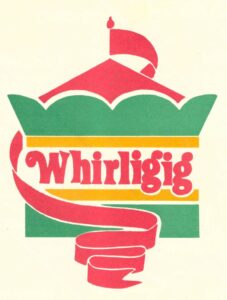 For a play aimed at primary-age children to tour the UK to mainstream theatres, playing daytime matinees for schools and weekend performances for the public, was virtually unknown until Whirligig opened its first production, The Plotters of Cabbage Patch Corner, at Sadler’s Wells Theatre, London in the autumn of 1979. Pioneers like Caryl Jenner had toured plays with Unicorn Theatre, but not to the larger or middle-scale venues. Richard Gill’s Polka toured puppets and actors to small theatres and, occasionally the mid-scale theatres like Oxford Playhouse. Theatre In Education had been developing strongly since the 60s and its beginnings at the Belgrade Theatre, Coventry. But TIE was very much intended to work in schools, not theatres. That was the whole point.
For a play aimed at primary-age children to tour the UK to mainstream theatres, playing daytime matinees for schools and weekend performances for the public, was virtually unknown until Whirligig opened its first production, The Plotters of Cabbage Patch Corner, at Sadler’s Wells Theatre, London in the autumn of 1979. Pioneers like Caryl Jenner had toured plays with Unicorn Theatre, but not to the larger or middle-scale venues. Richard Gill’s Polka toured puppets and actors to small theatres and, occasionally the mid-scale theatres like Oxford Playhouse. Theatre In Education had been developing strongly since the 60s and its beginnings at the Belgrade Theatre, Coventry. But TIE was very much intended to work in schools, not theatres. That was the whole point.
One of my first professional acting jobs was in the first TIE team based at the Palace Theatre, Watford. This was in 1967. I loved the work, which involved acting several parts in The Tay Bridge Disaster then going into a classroom to discuss the performance and the notion of collective responsibility highlighted in the play. However, I couldn’t help thinking that the theatre experience was as valid, if not more valid, than the theatre-in-school experience. I wanted children to feel the excitement of the lights going down, the music starting, the curtain going up and the theatrical magic that could be created on stage. Many TIE pioneers didn’t feel the same way. I think that to them the idea of ‘the magic of theatre’ was too romantic. They saw theatre as a tool with which to educate. I certainly never disagreed with that, but felt that the two approaches to theatre were valid. One of the problems had been that the mere phrase ‘children’s theatre’ suggested something rather tacky, tinselly or second-rate. This was not entirely fair, in spite of the fact that budgets were often considerably less than those for adult theatre, because the seat prices for children were, rightly, low.
Two things happened to me in that year – 1967 – that helped convince me that theatre for children was an exciting branch of theatre, something I could do reasonably well, and something that I would like to do more of. First, I was asked to act and direct at the newly-formed Worcester Repertory Theatre, based at the Swan Theatre, Worcester. This led to me writing my first children’s play, an adaptation of Hans Christian Andersen’s The Tinder Box, which was given its first production for Christmas that year. Second, following my happy experience in the Watford TIE team, I was invited to play in the annual Watford pantomime – Wishee Washee in Aladdin. Directed by Giles Havergal, written by Oxford contemporaries Michael Palin and Terry Jones, with music by another Oxford contemporary, John Gould, the show was not only great fun to be part of, it also gave me the chance to explore the excitement of audience participation, something I knew a bit about, thanks to doing magic at children’s parties, and also organising Saturday morning children’s theatre at Worcester.
The Tinder Box was not a brilliant piece of work, although it was given a faithful, sincere production (I hate the word ‘sincere’, but it best says what I mean), in which there was no overt playing to the adults, over the heads of the children, something which often happened in commercial pantomimes. The story was told honestly, with humour (not tongue-in-the-cheek) and a serious attempt at storytelling. This was in the belief that children love a good through-line story. I never saw the production myself, but it was good enough for John Hole, the theatre director at Worcester, to invite me to write another children’s musical play for the following Christmas. This turned out to be The Owl and the Pussycat went to See…, based on the verses and stories of Edward Lear, co-written with Sheila Ruskin. It was significantly to affect the course of my career. Having witnessed ten performances from the back of the auditorium, and having marvelled at the passion and spontaneity of the audience reaction, I knew this was an exciting branch of the theatre that I must do more of. Indeed, I was determined that The Owl and the Pussycat went to See… didn’t end after its Worcester premiere. A year later, I had managed, thanks to the help of many others, to put it on in a London theatre. It became very successful, was published by Samuel French, then for years afterwards played in most of the regional repertory theatres of the UK.
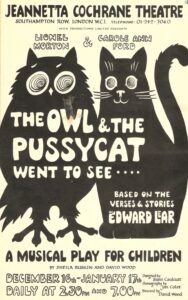
The London production of Owl was mounted by WSG Productions Ltd. The initials stand for Wood (myself), Scott (Bob Scott, later Sir Bob Scott) and Gould (John, the aforementioned composer/musical director/performer). The three of us had first met in 1964 at Oxford University, where we were involved in a production called Hang Down Your Head and Die, an anti-capital punishment revue, that achieved the unusual feat of transferring from the Oxford Playhouse to the West End. Michael Codron, the celebrated West End producer, was brave enough to bring our undergraduate efforts to the Comedy Theatre. We received great reviews and our six-week season was very successful and, for all of us, I fancy, an amazing experience. I was 20 years old. I had wanted to work in the theatre for almost as long as I could remember. Coming so soon to the West End was a dream come true.
Over the next two years, Bob, John and I worked as a cabaret trio, writing and singing silly songs, at Oxford Balls, cabaret evenings, and even for two seasons in West End night clubs. When final examinations were approaching in 1966, we decided to try our luck at that year’s Edinburgh Festival. John and I had both taken part in Oxford Theatre Group’s productions up there, and now we felt we could go independent. We augmented our trio by recruiting Adele Weston, another Hang Down Your Head and Die cast member, with whom we had done other shows. Her singing abilities tuned in with ours. We were now able to do four-part harmonies, a spoof on a madrigal, for instance, and we were aware that an all-male trio might not work as well on stage in a revue as in a cabaret room. The show was called Four Degrees Over, for obvious reasons, and we managed to get several theatres to book us to play before arriving in Edinburgh. A mini-tour. We started compiling material.
Another excitement in 1966 was the arrival in Oxford of Richard Burton and Elizabeth Taylor, who came to take part in an Oxford University Dramatic Society production of Doctor Faustus. Burton had promised his tutor, Nevill Coghill, when the war ended his studies at Exeter College, that he would return. In the meantime, of course, he had become a huge star and married Elizabeth Taylor. But he was determined to do something for Coghill. It was thought that the proceeds from the Doctor Faustus production would go towards building a studio theatre. Bob Scott was asked to play the Chorus and to understudy Burton. I was invited to play Wagner, Faustus’ servant. My girlfriend at the time (later my first wife, Sheila Ruskin) was Elizabeth Taylor’s understudy. She had also been asked to design Four Degrees Over.
Doctor Faustus was another incredible experience, ending up with a splendid party at the Randolph Hotel. Wood, Scott and Gould were asked to provide the cabaret. Afterwards, talking to the Burtons, who were kind enough to say they had enjoyed our performance, we somehow plucked up the courage to ask them to become Patrons of WSG Productions (not a limited company at this point), so that their names could be on our letterhead and hopefully impress people! At that point I was still booking our tour, writing to theatres and offering them something which was a totally unknown quantity.
The Burtons not only agreed, but also offered to donate £250 towards our enterprise. In those days this was an extremely useful sum of money!
Four Degrees Over became another extraordinary experience for all of us. We had good reviews on tour, and very early on, Michael Codron, who had transferred Hang Down Your Head and Die, offered to do the same for Four Degrees Over. He suggested some changes to the show, to which we agreed. He found us a director (up until then, we had directed ourselves), John Cox, who became a celebrated opera director. He asked us which West End theatre we would like to play in! We immediately replied that the Fortune would be perfect. For us it meant Flanders and Swan, Wait A Minim and, most of all, Beyond the Fringe, shows which we all had admired hugely. Although we certainly didn’t become a cult success, Four Degrees Over played at the Fortune for a couple of months. We even had a cast album produced by the legendary Beatles’ producer, George Martin.
Bob, John and I now had to make our individual ways in the big, bad world … But WSG Productions still existed, and in 1967, John and I produced and performed in another touring revue called Three to One On. Again, we went to the Edinburgh Festival. No West End transfer, however, but a ‘special’ on BBC2 television.
Over the next few years, WSG became a limited company and put on several productions, all of them home grown. John performed a one man show, featuring his humour at the piano. He wrote a lovely musical revue based on John Betjeman’s poems called Betjemania, which we toured and produced in London. Another version of John’s one man show, Bars of Gould, was heard on Radio 4, and played at the Mayfair Theatre in London, co-produced by Bill Kenwright.
Meanwhile, we were all doing our own things as well. I was acting. Bob was becoming a theatre administrator, notably in Manchester at the 69 Theatre Company, which later became the Royal Exchange. Adele had become a teacher, and later started writing very successfully for children.
The success of The Owl and the Pussycat went to See… in 1968 made me determined, as I wrote earlier, to get the show on in London. WSG Productions seemed the ideal vehicle, if we could find the money. Luckily, both John and Bob were very willing to let our partnership go in a slightly different direction. Friends, including Michael Palin, put small sums of money into the pot. We secured the Jeannetta Cochrane Theatre, in Southampton Row, off Kingsway, a theatre that was the perfect size and was not officially regarded as a West End theatre which would have been far more expensive. Because the budget was tight, we found it difficult to find a director. Those we approached either wanted more money than we could pay or were put off by the knowledge that this was a children’s play. Having by now directed a couple of plays at Worcester, I offered my services. So, for the first time, I directed a children’s play. Again, this was something that changed the course of my career, really. I found I enjoyed doing it. It seemed that I could do it reasonably well. I didn’t need to be paid, should the budget be too stretched. Bob introduced me to Susie Caulcutt, a new theatre designer, who did a wonderful job on the set and costumes. Malcolm Sircom, the musical director who had worked on the show’s premiere at Worcester, and done the musical arrangements, was the musical director, playing the piano. There was certainly no money for any other musicians. And we found a choreographer called Jan Colet, who proved to be a great team member, not only arranging the dances, but also spending his spare time painting bong leaves for the set and helping to paint the Jumblies’ boots pink!
We were lucky enough to get two ‘names’ in the cast. Carole Ann Ford played Pussycat. She had been Dr Who’s first assistant in the iconic television programme. Lionel Morton, who played Owl, had not only been in a successful pop group, The Four Pennies, but was also a regular presenter of BBC tv’s Play School.
We opened happily, having had only two weeks to rehearse. I had previously spent hours going through telephone directories, hand-writing envelopes in which to send publicity material to London primary schools. The set was built too cheaply, and its main circular raked disc structure had to be taken apart and rebuilt, using screws instead of nails … but somehow the show went on and got a wonderful review in the Evening News. The box office phone became hotter and hotter and the elderly lady in the box office – the only employee in the box office – became overstretched. I helped out, as did the director of the theatre, Mick Orr. The production, which only played for three or four weeks, broke even, enabling us to repeat the experiment the following year (Christmas 1970).
For Christmas 1971, the West End impresario Eddie Kulukundis took WSG’s production of Owl into the West End, to the Apollo Theatre. Eddie had employed me twice as an actor – in David Mercer’s After Haggerty, which he transferred from its Royal Shakespeare Company Aldwych Theatre home to the Criterion, and in Alan Ayckbourn’s Me Times Me, at the Phoenix, Leicester and on tour. Eddie kindly came to see Owl at the Jeannetta Cochrane Theatre, loved it and offered to bring it into town in association with WSG. Not only that, he was interested in my new play, The Plotters of Cabbage Patch Corner, which had opened at the Swan Theatre, Worcester for Christmas 1970. So, along with Owl at the Apollo, Eddie put Plotters into the brand new Shaw Theatre on the Euston Road. It played there for two Christmas seasons. Julia McKenzie played Ladybird the first year. The production was directed by Jonathan Lynn, who had never directed a children’s play before. He later established himself as the co-writer of the brilliant tv series, Yes, Minister, and went to direct movies in Hollywood. We had already employed him on a couple of grown-up WSG shows, directing a revival of our revue Four Degrees Over and also John Gould’s one-man show. Jonathan proved to be the perfect children’s play director, because he never patronised the audience. He treated the play as seriously as if it were an Ibsen! Plotters received great reviews. Susie designed the stunning set and costumes.
Owl didn’t play Christmas 1972, but we brought it back to the Jeannetta Cochrane Theatre for Easter, 1973, when, sadly, part of the ceiling fell in during an early performance. There could have been fatalities, but, by a miracle, the four unoccupied seats took the main impact. We transferred to the Collegiate (later the Bloomsbury) Theatre, and managed to recoup our subsequent losses from the local council, who owned the Jeannetta Cochrane Theatre, which remained closed for a couple of years.
Also in 1973 David Wright, who was one of the National Youth Theatre management team, got in touch. The NYT were the tenants of the Shaw Theatre, in the Euston Road, which had opened two years previously. John Gould and I had known David since our Oxford days, when he co-devised Hang Down Your Head and Die, the anti-capital punishment revue which had transferred from the Oxford Playhouse to the West End in 1964. David said that they had been pleased with The Plotters of Cabbage Patch Corner, which had played the previous two Christmas seasons. He wondered if I had anything else to offer for Christmas 1973. I suggested Larry the Lamb in Toytown, the adaptation by Sheila Ruskin and myself that had originally been commissioned by the Swan Theatre, Worcester in 1969. As a highly successful radio programme in the 50s, and also as a television animation series in the 60s, Larry the Lamb and his friends were very well-known characters. Sheila and I had persuaded Hendrik Baker, an ex-stage manager who had worked with Larry the Lamb’s creator, S.G. Hulme-Beaman, and was in charge of all the rights, to let us create a stage play. The Worcester production had gone down well. David and the Shaw management liked the idea. I discussed with John the possibility of WSG Productions Ltd. presenting the play, and set about trying to find enough money to put it on. The Shaw’s producing company, a kind of professional arm of the National Youth Theatre, was called the Dolphin Theatre Company. They became our co-producers, giving us the use of the theatre and help with publicity. But we needed several thousand pounds investment. Our Jeannetta Cochrane theatre productions of The Owl and the Pussycat went to See… had been artistically well received, but had not made money.
Fate offered a friendly hand. In the summer of 1973 I was acting in The Provk’d Wife at Greenwich Theatre. In the cast was Linda Thorson, who had found fame as Tara King in The Avengers, the extremely popular television series. One night, waiting in the wings for the opening of the play, I told Linda about our Larry the Lamb plans and hopes. She happened to be the partner of Laurie Marsh, a very successful businessman, who had owned all the Classic cinemas, and was involved in West End theatre ownership and production, with partners such as Ray Cooney and Brian Rix. Linda kindly organised a meeting, and Laurie, even more kindly, came up with the necessary funding. Larry the Lamb in Toytown, with lovely, colourful, faithful-to-the-original, sets and costumes designed by Susie Caulcutt and with musical direction by Peter Pontzen, and directed by myself, was well received. Melody Kaye, a future Whirligig stalwart, played Larry, Veronica Clifford – who later created the role of The Old Bag in my play The Gingerbread Man, played Mrs Goose and Geoffrey Lumsden, a sporting, elderly old-school actor, played the Mayor. The Mayor’s Clerk and the Baby Dragon were played by Ian Judge, who later became a successful opera director. Ian hated wearing his beautiful but hot and head-covering Dragon costume, but the audience absolutely adored him. Unfortunately the business at the box office was very disappointing, and even more unfortunately, the generous Laurie Marsh lost all of his investment…
Round about this time I met Cameron Mackintosh. He introduced himself to me at a party celebrating the opening of the Noel Coward bar at the Phoenix Theatre. He said that he loved The Owl and the Pussycat went to See…, and had visited several regional productions. If there were any chance, he said, of working on that show with you, I would be honoured! Cameron, at that time, was in the early stages of his brilliant career, touring plays on a shoe string. We did indeed work together on Owl, putting it on at the Yvonne Arnaud Theatre, Guildford for a Christmas season, then asking another director, John David, to do a production at the Gardner Centre, Brighton. This later toured and came into the Westminster Theatre, London.
WSG had been happy for me to progress this new alliance with Cameron. We certainly didn’t feel that WSG could take on a tour at this point. We were all quite busy on other things.
Cameron and I also produced Owl at the Towngate Theatre, Basildon, a small theatre in Essex. It was very well received.
So, the following year, 1976, the Towngate commissioned me to write a new play. I managed to get the Theatre Royal, Norwich to commission it in return for the touring rights for one year. The play turned out to be The Gingerbread Man. Cameron came to see it at Basildon and offered to co-produce it with me in London the following Christmas. We opened for Christmas 1977 at the Old Vic, where we received great reviews and were invited back for Christmas the following year. Eventually, the play became my biggest success, playing in London for many Christmas seasons, and touring many times. It also took off internationally, particularly in Germany. Indeed, WSG Productions occasionally produced The Gingerbread Man – exactly the same production! – without Cameron’s involvement. Similarly, Unicorn Theatre produced it a couple of times – again, the same production!
The Gingerbread Man was directed by the Plotters director, Jonathan Lynn. He did a wonderful job. He eventually directed it three times, but then had no further time to devote to it, so I took over. Really, I reproduced his production, occasionally tweaking it or cutting the odd line, but basically it stayed the same for many years – indeed, the 25th anniversary performances at Norden Farm Theatre, Maidenhead, used exactly the same set – not just the same design, the same physical set, which still looked great and worked well. It was designed, as have most of my children’s plays been, by Susie Caulcutt.
In 1997, the Towngate, Basildon asked for another production for Christmas. I suggested Flibberty and the Penguin, the play I had written for the Swan Theatre, Worcester in 1971. The Towngate produced it themselves. Little did I realise this production would later become the pilot production for Whirligig Theatre …
So, by 1978, several of my plays had been performed in various venues, and had toured a certain amount. Cameron and I had toured The Owl and the Pussycat went to See… and a tour of The Gingerbread Man was on its way. But there was still very much the feeling that my plays were achieving success for just a few weeks each Christmas-time, and that a year in the life of a child is a long time! It seemed crazy not to give people all over the UK the chance to bring their children to see the shows locally. Touring was the answer. But it was not a simple thing to organise. I was well aware of the fact that it was financially incredibly difficult to make ends meet, particularly if the plays were of the scale I wanted – most of them had a cast of ten or twelve. Not only that, many of the theatres were not interested in a show that played mainly daytime performances. They insisted, if they were to take a children’s show, that it should fit on top of an evening attraction. Our sets tended to be quite large, and very tricky to fit on top of another set. There was, too, an attitude amongst theatre managers that simply didn’t view children’s theatre as particularly important, necessary or commercially viable. So I knew that my dream of touring quality children’s theatre to major theatres was not something that could easily be fulfilled. I recognised that sponsorship or subsidy would be essential. Sponsorship was almost a dirty word in Arts Council circles in those days. Arts sponsorship was in its infancy. And there was very little money available from the Arts Council for children’s theatre. I don’t think the Touring Department had ever subsidised a children’s tour.
So it was, in 1978, that John Gould and I met in the Hand in Hand pub on Wimbledon Common to discuss whether or not we could find a way forward to establish a touring children’s theatre company, to perform in major venues, targeting primary school audiences on weekdays and family audiences at weekends.
We agreed that we should aim to work towards establishing a touring company, by planning a pilot tour in the autumn of 1978. We decided that Flibberty and the Penguin would be a reasonable choice of play. I still had the physical production stored in my garage. The Basildon production, which I had directed, had been well received. Also, it had attracted a strong cast, including three television names. Brian Cant, the Play School legend, George Layton, actor/writer (Doctor in the House) and John Cater, currently recognisable from the series The Duchess of Duke Street. Flibberty had first played at the Swan, Worcester – the fifth annual commission from John Hole. The play was about a Penguin who had lost his parents. Flibberty, a kindly goblin/pixie/elf character, helps him. The play is really a quest that ends up at the zoo, with the happy reunion of the Penguin family. I saw it as a kind of Feydeau farce, full of mistaken identities. Mr Maestro, a famous orchestral conductor, wearing a tailcoat, gets mistaken for the penguin. There is also confusion because another kind of conductor, a bus conductor, is also a major character. Added to this, Mr Maestro, being so musical, cannot understand you if you speak to him – you have to sing to him. A villainous Krafty Kingfisher is in pursuit, and a comedy policeman adds to the mayhem. There are also two Silly Cuckoos, vying with each other to become the first cuckoo of spring. Looking back, it was really quite a complex plot! Susie Caulcutt had designed a lovely set and some beautiful costumes.
As WSG, we managed to get a short tour with most of the theatres paying a guarantee that would contribute a guaranteed sum to the costs. The Arts Council, to our surprise I think, gave us a small but welcome subsidy. And the Alfred Beck Centre, a newly-opened venue in Hillingdon, Middlesex, invited us to do a Christmas season. Roger Edwards, who ran the theatre, needed a name to sell the show. I remember checking the availabilities of many children’s television presenters and other well-known actors, and eventually securing the services of Johnny Ball to play the Bus Conductor. Johnny was very well known on children’s television, and just had a few weeks’ availability. He definitely helped box office sales. The tour and the Christmas season were well enough received to make us determined to press forward with our plans to establish a regular touring company.
The tour had opened at the Civic Theatre, Darlington, thanks to the Theatre Director Peter Tod. Over the years, Peter became very important in Whirligig’s story. At Darlington and later at the Bristol Hippodrome, he regularly invited us to open our productions or visit on tour, giving us a decent guarantee to cover the costs. His commitment to our aims – to reach as many primary school children as possible – led him to offer the seats at low prices. The business was tremendous, even if the box office take was not enormous, compared with adult productions. Peter never minded this. He saw regional theatre as a service to the community. Children were part of that community and deserved their own special productions. Peter became a great ally.
The other theatres we played were not the grandest or the biggest, but all enthusiastically received us. The Thameside Grays, Theatre Royal Newcastle, Palace Theatre Newark, the Rex Wilmslow all took quite a risk with us, bearing in mind that, in those days, few theatres had marketing departments, and the notion of doing direct mailing to schools was in its infancy.
It must have been in June 1978 that Jacqui, my wife, and I were on holiday in Menorca. English newspapers were expensive, so we restricted ourselves to a Sunday paper, which had lots of sections and supplements. Some of these we would not normally have read but, in the circumstances, each section was given a serious look. Jacqui discovered an article about a man called Bill Kallaway, who had set up an arts sponsorship business. He seemed to be a pioneer, trying to put together artistic ventures and commercial companies willing to give sponsorship, not necessarily as philanthropy, but as a business proposition.
When we returned home, I got in touch with Bill Kallaway, who invited me to a meeting. He seemed sympathetic to WSG’s ideas and asked for some more detailed, written plans. He said he would then do his best to find us some sponsorship for a possible tour. He felt that we needed a name for the company. Very quickly I came up with ‘Whirligig Theatre’, partly because there had been a television programme in my childhood called Whirligig, which had been a great favourite, and also because the word suggested ‘going round’, which was exactly what touring meant.
To our surprise and delight, Bill Kallaway delivered! It wasn’t long before he told us that Clarks Shoes were interested to support us. It seemed – and, indeed, proved to be – an ideal match. Clarks were well known for caring about children’s feet. There would be nothing controversial about them supporting us. It would have been impossible, for instance, to have a sweet manufacturer or a cigarette company sponsoring us. John Gould and I met various representatives of Clarks and plans were made to launch the company with a tour of The Plotters of Cabbage Patch Corner, opening on October 9th, 1979, at Sadler’s Wells Theatre in London.
1979
We were extremely fortunate to secure Sadler’s Wells, a prestigious London theatre, particularly noted for its dance programme. Historically, it is often linked to the Old Vic, because the remarkable Lilian Baylis made it her life’s work to programme both theatres with culture for a mass audience both north and south of the river Thames.
Derek Westlake was running Sadler’s Wells at the time. I like to think he was sympathetic to this new children’s theatre company and its work, rather than just filling a vacant slot! I’m sure his heart was in the right place, however, because he offered us two weeks of daytime performances, without insisting we play on top of an evening show. On Saturday we did two public performances, but, again, not an evening show. He also offered us two weeks, which we had not expected, but which helped establish us by giving audiences and critics a bit more time to come and assess our work. It was notoriously hard to tempt the critics to review a children’s production. But Plotters certainly succeeded.
Derek’s faith in us was bolstered by his decision to invite us back the following year. And Sadler’s Wells subsequently became Whirligig’s London ‘home’. This was a great help to us. A regular London date helped us get publicity. It also was an attraction to actors, who were more likely to join the company when they knew they had a London showcase. Furthermore, we were, as the years went by, able to announce a Whirligig season months ahead, so that schools could pencil in their requirements and, once they trusted us, make Whirligig a regular school trip.
We chose Plotters for our launch, partly because there was already a physical production, but also because its two London Christmas seasons at the Shaw Theatre, in 1971 and 1972 had been very well reviewed.
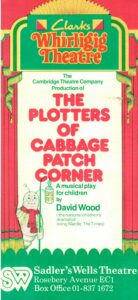
Furthermore, Jonathan Lynn, who had directed the two London seasons of Plotters, had by now been appointed Artistic Director of the Cambridge Theatre Company. I had been delighted when he announced that he wanted to produce The Plotters of Cabbage Patch Corner at the Arts, Cambridge. Now it seemed sensible for Whirligig Theatre to present the Cambridge Theatre Company production of the play. Jonathan agreed.
The play had originally been commissioned by the Swan Theatre, Worcester, where it played the 1970 Christmas season. When I had asked Jonathan to direct the 1971 production, he had employed as choreographer, Sheila Falconer, who had done a splendid job. Sheila focussed more on movement for actors than full choreography, with the result that the insect characters came vividly to life, all moving in their own idiosyncratic way. Sheila, who had previously worked as Gillian Lynne’s assistant, became an invaluable member of our Whirligig team. She was involved in every show we created, over the full 25 years the company existed. Because Jonathan was otherwise engaged, it was decided that Sheila should direct Plotters, and she did so brilliantly.
Susie Caulcutt’s set and costumes were refurbished and looked as good as new. In the cast were several actors who became Whirligig regulars. Melody Kaye, who had played the Penguin in Flibberty and the Penguin the year before, returned to play Maggot. Mike Elles was a slimy Slug, and Lucy Fenwick played Ladybird.
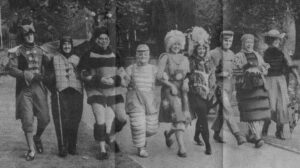
Another vital ingredient in the Whirligig mix was Peter Pontzen, the musical supervisor. Like Sheila Falconer and Susie Caulcutt, Peter was involved with every Whirligig production. He first came into my life in 1970, when I went to see a repertory production of The Owl and The Pussycat went to See… at the Crewe Theatre. It may have been called the Lyceum, then. Ted Craig, the Artistic Director, had both directed the play and played – rather well – the Turkey. After the show he invited me to meet the cast. I asked immediately if I could meet the musical director too. Peter had played the piano for the show exactly as I had always imagined the music should be played. I told him this, and asked for his contact details, in the hope that we could work together at some point.
The following Christmas (1971), Owl was playing in London, and Plotters was coming to the Shaw. We needed an extra Musical Director, so Peter was appointed. He was brilliant. He then worked regularly on my productions, and, having worked for Whirligig from day one, also stayed for the duration. He also became my musical supervisor, doing the musical arrangements of all my songs for virtually all my musical plays. He was an indispensable member of the team.
Two other dedicated company members were Chris Stringer and Kevin Chadderton. Chris had already worked for WSG Productions as a Production Manager and as a Company Manager. Kevin’s first production with us, as Deputy Stage Manager (on the book) was Plotters. He stayed as DSM, until promoted to Company Manager, for the next 25 years.
Clarks made sure that they supported us with more than financial subsidy. They provided – in their company colours – all our printed publicity, as well as a beautifully produced free cut-out toy theatre of Plotters, plus a free programme for every child, comprising a comic-strip telling of the story. These giveaways were the beginnings of our responsible attitude towards schools. Although we didn’t want to be seen as an overtly ‘educational’ company, nevertheless we wanted teachers to see how our plays could trigger the children’s imagination. We may not have been doing plays that related directly to what subsequently became known as the National Curriculum, but we wanted teachers to use the theatre experience to encourage children to write or to draw pictures or to act out scenes from our plays. So we began preparing Teachers’ Packs, something that was unusual in those days for a touring theatre production as opposed to a TIE tour into schools. We also organised Teachers’ Seminars, at which we would talk about the play, show the designs, discuss ways in which the teachers might instigate follow-up work, and generally make them feel that we were providing theatrical entertainment as a genuine introduction to theatre for children, rather than as a purely commercial exercise. At Sadler’s Wells, we made a point of inviting the teachers to enter the theatre via the Stage Door and take the service lift to one of the ballet rehearsal rooms, in which celebrated ballerinas like Margot Fonteyn had practised. Hopefully the teachers enjoyed feeling part of our adventure. Certainly we used to get a good attendance, until, as the schools began to trust us more and more, fewer teachers would come, yet box office numbers would increase.
The tour of Plotters visited more theatres than the Flibberty pilot. We played at the Gordon Craig Stevenage, the Grand Wolverhampton, the Poole Arts Centre, Darlington Civic, Sunderland Empire, Newark Palace, Theatre Royal Hull, then opened for a Christmas season at the Hexagon, Reading. I think we were their first ever Christmas production, the theatre having only recently opened.
It might be worth saying at this point that Whirligig Theatre never occupied an office. John Gould worked from his home in Wimbledon, then Brighton, as I did. By now I had been fortunate enough to employ a part-time secretary/assistant. Barbara Shipton worked on Whirligig’s behalf as well, half her salary being paid by the company. John, having trained for several years as a chartered accountant, coped admirably with the finances, including budgets and the company’s wages. I did the publicity blurbs and press releases. Somehow we managed to keep everything going in this somewhat makeshift manner. In later years, we shared the workload with Barry Sheppard, whom we were delighted to welcome as Administrator, when his contract running the Oxford Playhouse was terminated, and the theatre temporarily closed. Barry had been a great supporter of Whirligig, booking us into the Oxford Playhouse regularly. We always did excellent business there. Barry started working for Whirligig in 1988; until then, John and I, helped by Barbara, ran the company as efficiently as we could. Indeed, it may be argued that having so few cooks actually contributed to our efficiency – Stephen Remington, who ran Sadler’s Wells for several years, told us we were the most efficient company he dealt with …
Sadler’s Wells was an exciting place to be. But, in all honesty, it wasn’t the easiest theatre for children’s theatre. The auditorium was large and between it and the stage was an enormous orchestra pit. Whirligig budgets never stretched to more than one musician, so the pianist/keyboard player would sit all alone, sometimes boxed in by a black forestage covering the rest of the pit. In fact this large gap between the stage and the audience felt worse for the actors than for the spectators, because the sightlines in both the stalls and the circle were cleverly designed to ‘lose’ the orchestra pit when sitting. But, without microphones or sound enhancement of any kind, it was a tribute to the cast that they could be heard throughout the theatre. And the volume and passion of the audience participation must have taken the Sadler’s Wells resident crew by surprise. We had been somewhat concerned that they might have resented the arrival of a children’s show in a venue used to high-class ballet and opera. Indeed, on the morning before the technical rehearsal, I listened in to a conversation over the headphones as I sat at the production desk. An electrician was expressing somewhat disparaging remarks about our ‘kiddies’ show’. It was truly rewarding when, in the pub next door at our post-opening gathering, the same technician went out of his way to say how exciting and electrifying he found our performances, because of the incredible gut reaction and uncynical enthusiasm of the audience. It’s probably true to say that Sadler’s Wells had never before witnessed audiences of primary school parties. Over the years we came to treasure our Sadler’s Wells weeks, when we proudly displayed our wares to London.
One heartstopping memory from Whirligig’s first production came alarmingly early in the run. I think it was the second performance, a morning schools’ performance, which we knew several national newspaper critics would be attending. When the actors arrived for their warm-up, one was missing. Red Admiral, one of the insects in the play hadn’t turned up. By the end of the warm-up and the announcement of ‘the half’ (thirty-five minutes before curtain up) there was still no sign. And there was no answer from the telephone number he had left with the company manager. After another ten minutes we made the decision that the understudy would have to go on. Robin Kermode had had no rehearsal. As assistant stage manager he had spent much of the rehearsal time gathering props. But, in this emergency, it is to his eternal credit that he put on the costume for the first time, showed that he had learnt the lines and been making notes of his entrances, moves and exits, and was, to boot, a real trouper. He got through the play with considerable style. The reviews next day were positive. Thank you, Robin. The real Red Admiral eventually arrived, mortified, having overslept. It didn’t happen again …
1980
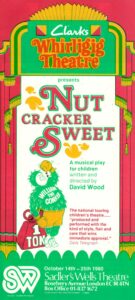
We were pleased to be invited back to Sadler’s Wells the following year, 1980. Clarks Shoes agreed to stay on board, having been pleased with the inaugural Plotters tour. So we planned another tour. The play chosen was Nutcracker Sweet, which had originally been commissioned by David Horlock, Artistic Director of the Redgrave Theatre, Farnham in 1977. David had been at school with me – Chichester High School – and we had both been members of the Chichester Youth Theatre. We both went to Oxford, too, although he was a year ahead of me. After Oxford he had become an associate director at Bristol Old Vic, where he had directed two of my plays – The Owl and The Pussycat went to See… and The Plotters of Cabbage Patch Corner. Now he was running his own theatre at Farnham, and kindly commissioned a new play for children. The plot involved a cast of nut characters, who were part of a Nutty May Fair. They were in danger from Professor Jelly Bon Bon, a high-class confectioner in search of choice nuts to cover with chocolate for his latest assortment. The life and death situation for the nuts grabbed the imagination of the young audience, particularly when, having been thwarted, the Professor turned his attention on the audience, threatening them with the fate of becoming Chocolate Children. David had cleverly directed the play at Farnham, but I wasn’t entirely happy with it. Samuel French had offered to publish it, but I asked them to wait until we had secured another production. A Whirligig tour was the perfect way of giving the play another chance, and I took the opportunity of directing it. The regular creative team returned. Susie designed it, Sheila choreographed, and Peter was the musical supervisor. Melody Kaye, Mike Elles and Lucy Fenwick, all of whom had been in Plotters, returned as Hazelnut, Kernel Walnut and Gypsy Brazil. A welcome new recruit was Caroline High as Old Ma Coconut. Caroline was married to Kevin Chadderton, who returned as DSM. Chris Stringer was the Company Manager and Production Manager once more.
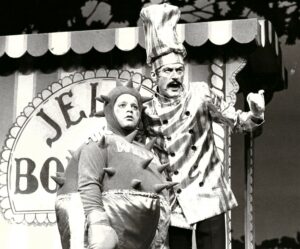
The Chocolate Squirter, as Professor Jelly Bon Bon became affectionately known, was played by a very tall actor, Richard Bremmer, who succeeded in causing some of the most passionate audience participation I have ever witnessed. The children loathed him and all he stood for, and when he got his comeuppance at the end – he himself was squirted by his own chocolate-squirting machine and became a giant piece of confectionery – they raised the roof with joy.
Clarks again provided the publicity, as well as sponsorship, plus an attractive giveaway to every child, comprising a series of finger puppets of the characters and interesting information about the nuts and where, in the real world, they came from. The newspaper critics were enthusiastic and teachers appeared to approve of the play, even though it was not overtly educational. Over the years it has been difficult to predict what teachers really want. Sometimes they look for a play that covers some aspect of the National Curriculum, other times they are happy to give the children a treat. Whirligig’s philosophy was always to make the plays entertaining, but to incorporate, with integrity, a problem or moral dilemma that the children would find interesting, using characters and situations that would appeal. This often, of course, involved fantasy and/or anthropomorphism, but, as we developed as a company and as, I think, I developed as a writer, we later turned to environmental themes, which offered teachers more contemporary material to follow up in the classroom.
Clarks gave us £36,000 towards the Nutcracker Sweet tour. We aimed to embark upon a longer tour – 20 weeks. Our guarantees for box office shares were budgeted at an average of £4,000 a week. This meant there was a potential shortfall of £24,000, for which we applied to Arts Council Touring.
It is worth recording here that throughout our 25 year history, the Arts Council regularly refused to make us revenue clients, which would have meant that we could plan ahead, in the knowledge that we would automatically be receiving subsidy the following year. We were always on ‘project grants’, which often meant we didn’t have confirmation of the grant or the amount until very late in the day. Often we had committed to theatres and already spent money on publicity print before knowing we could go ahead. And, as will be explained later, a couple of times we came unstuck and had to withdraw from a tour, because we simply didn’t have enough guaranteed funds.
For Nutcracker Sweet, eventually Arts Council Touring gave us £14,000, less than we needed. But, somehow, thanks to John Gould’s financial skills, we managed to scrape through without a deficit.
We opened at the Ashcroft Theatre, Croydon in August 1980, and toured through to January 1981. Our list of theatres was improving in quality. Some theatres invited us back, following reasonable business the previous year. And Sadler’s Wells continued their support by again booking us for two weeks. After Croydon we played the Arts Cambridge, the Palace Newark, the Key Peterborough, the Alhambra Bradford, the John Player Theatre in Dublin (two weeks, as part of the International Theatre Festival), two weeks at Sadler’s Wells, the Adam Smith Centre Kirkcaldy, the Theatre Royal Glasgow, the Civic Darlington, Bristol Hippodrome (to which Peter Tod had now moved from Darlington), New Theatre Cardiff, New Theatre Hull, Gordon Craig Stevenage, Oxford Playhouse, Buxton Opera House and the University of Warwick Arts Centre, where we played two weeks. This was to become the beginning of a fruitful relationship – in future years we often opened our productions at Warwick.
In November we learned, with great pleasure, that the Clarks sponsorship of Whirligig had won a coveted ABSA Award, as a top example of successful business sponsorship. It was a happy coincidence that we played Bristol Hippodrome round about that time, because Clarks had their offices and factory at nearby Street in Somerset. After the Saturday matinee performance, to which all the Clarks employees had been invited, we arranged a splendid tea party in the Circle Bar. It was an opportunity to say thank you to Clarks, but also for them to witness our work, and hopefully encourage them to stay with us!
1981
In 1981 it was agreed that we would tour Chish ‘n’ Fips. This was a play I had been commissioned to write for the 1980 Christmas season at the Liverpool Playhouse. William Gaunt, the Artistic Director, had generously given me a very open brief, except that ideally the cast should not exceed six. The play I came up with involved two garden gnomes, who, bored with their backyard existence, decide to go on an adventure into the concrete jungle of the big city. The subject matter offered nice opportunities to explore the dangers of urban life, including the difficulty of crossing roads. Road safety was a useful publicity tool when advertising to school parties. But I was careful to make sure that, in the audience participation, it was the audience who knew more than the innocent Gnomes, and, helped by Chips, the streetwise cat, taught the gnomes how to get across the road safely. This was less patronising than simply teaching the audience how to stay safe.
The play had been well received in Liverpool, but I was worried about the title. For some reason I had come up with the title long before thinking of what the play might be about! Bill Gaunt liked it, and started advertising the show before we had much clue about its content. As it turned out, there was indeed a character called Chips, but there was nothing that really related to Chish ‘n’ Fips… For days I struggled to come up with a better title, knowing that our publicity deadlines for the Whirligig tour were approaching. On the final day, I happened to see in the newspaper a reference to The Ideal Home Exhibition. Instantaneously, I excitedly thought of The Ideal Gnome Exhibition and seconds later revised it to The Ideal Gnome Expedition.
(It is worth recording that a few years later I wrote a television series based on the play. This time we reverted to the title Chish ‘n’ Fips, and justified it by setting the gnomes’ home in the back yard of a fish and chip shop.)
The usual team returned – Susie, Sheila and Peter – and, returning for a second year was Paul Knight, a musical director who gave excellent service to Whirligig for several years. Mike Elles and Melody Kaye returned in the cast, and Keith Varnier, who had several times by now played Sleek the Mouse in The Gingerbread Man for Cameron Mackintosh and myself, joined the company to play Chips, the cat. There was a character called Wacker, who was a tar-whacking machine (when writing the play for Liverpool, I was delighted to find that the trade name of such a machine was indeed Wacker, which, of course, is also the Scouse (Liverpool) word for ‘mate’ or ‘friend’. In the original Liverpool production, this role, as well as the role of Securidog, a fierce animal guarding an adventure playground, was played by Daniel Webb, who, as Danny Webb, later became very well known in adult theatre. In our touring production, we were lucky enough to employ – in his first role, I think – the splendid Clive Mantle.
For the first time, we rehearsed in the church hall of St Mary, Newington, in Kennington – a hall that was to be our rehearsal home for many years.
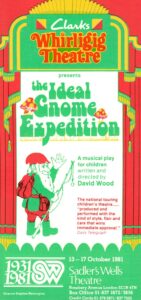
The sets were impressive and extremely large! They almost symbolised our wish to be providing substantial theatre productions rather than Theatre In Education tours, in which the cast and the set would tour together in one van. We almost over-compensated. Another reason, of course, was that my play used scale as its main ingredient. The gnomes, played by human-sized actors, had to have ‘giant’ backgrounds to act against. So a pavement with a gutter became a considerable hurdle – and a large piece of scenery. And just as there was a giant flowerpot in The Plotters of Cabbage Patch Corner, in The Ideal Gnome Expedition, there was a giant dustbin. Clarks Shoes came in with £18,000 plus an extra – special – £2,000 to help us introduce theatre to the Gaumont Cinema, Doncaster.
After considerable negotiation, Arts Council Touring gave us £18,000, and South Eastern Arts gave us £750 towards our Eastbourne date.
We opened at University of Warwick Arts Centre, then played Bristol Hippodrome, Gordon Craig Stevenage, Towngate Theatre Basildon, New Theatre Hull, Civic Darlington, Buxton Opera House, Adam Smith Centre Kirkcaldy and the Oxford Playhouse. Then we managed to secure a short Christmas season at the Gardner Centre, Brighton.
Clarks provided us with give-away badges for every child. Encouraged by Clarks, we organised a competition for children, asking them to imagine that they were one foot high – Gnome’s Eye View.
1982
In 1982 we prepared our fourth annual tour. In spite of the fact that the tour was shorter – twelve weeks, we were more than grateful for support from Clarks (£22,000) and from Arts Council Touring, who surprised us a little by offering us a guarantee against loss of £38,000. The total budget was nearly £140,000, not an insignificant sum.
Looking back, this was one of the most straightforward of Whirligig’s touring years. Our net box office receipts ended up at just over £131,000. Whirligig, of course, only took a share of these receipts, but, with the sponsorship and subsidy, it was possible to make the figures work.
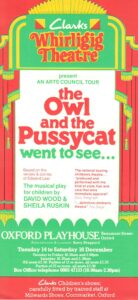
Having said that, we hadn’t felt confident enough to embark on a brand new production. We chose The Owl and The Pussycat went to See… written by myself and Sheila Ruskin, first produced at the Swan Theatre, Worcester in 1967. Since then, the play had become popular amongst the regional repertory companies. Based on the verses and stories of Edward Lear, it offered entertainment value, plus, for the schools, interesting follow-up possibilities using Lear’s classic rhymes and characters. Following earlier tours by Cameron Mackintosh and myself, there was a reasonable physical production in existence. It needed quite a bit of refurbishment and not all the costumes were still usable, but the money we saved enabled us to employ a larger company than the previous year. The cast of twelve included regulars Melody Kaye and Lucy Fenwick, plus the return of Stephen Reynolds, who had been in Flibberty and the Penguin for WSG and Allan Stirland, who played the Plum Pudding Flea for the umpteenth time since the first London production of the play in 1969. Newcomers Malcolm Ward and Jane Arden were excellent as the Owl and the Pussycat. Wenda Holland, who later became a successful theatrical agent, Shaun McKenna, who went on to write the spectacular Lord of the Rings musical, and Tim Bannerman, who had, the previous year, been in the cast of Meg and Mog Show, my show produced by Unicorn Theatre. John Dallimore, Richard Sockett and David Goodwin completed the excellent cast. The two understudy/ASMs were Gary Raynsford and Sally Cookson, both having just graduated from LAMDA. Sally later became an extremely successful deviser and director of children’s productions. In those days, actors had to be members of Equity in order to join a company. But most touring companies and repertory companies could take on two acting ASMs, who could automatically apply for membership of the union. With Gary and Sally, we had a tussle with Equity and the Theatrical Management Association, which centred round whether or not we were a number one touring company. We were deemed NOT to be, but compromise was reached when we agreed that Sally and Gary would not understudy principal roles, only secondary ones. I remember we were displeased that, because we played to children, we were not given number one touring company status, even though we were playing many number one touring theatres.
Susie, Sheila and Peter all returned as the creative team. I directed again. Lighting was by Bill Bray, the resident lighting technician at Chichester Festival Theatre, who had lit the play when it played a Christmas season there. He did an excellent job, although I think he was taken by surprise at how speedily he had to supervise the lighting rig and design his cues. By then, we had got used to the fact that we would usually get-in to our first venue on the Sunday, do technical and dress rehearsals on the Monday, and open on the Tuesday morning.
We used several different lighting designers over the years. Steve Kemp, a splendid ally, had lit Plotters and Ideal Gnome. He died tragically young. Later, Roger Frith, the incomparable Robert Ornbo and others took on the tricky task of making our shows look beautiful, using an uncomplicated rig which could be reproduced in all the other venues.
Everybody working for Whirligig, in whatever capacity, was employed on a fee per production basis. In twenty-five years, we never had one full-time employee.
The Musical Director was Simon Lowe and Paul Farrah was the Sound Designer. Paul was, at the time, developing his lighting and sound hire company. He designed the sound for many of our future productions. Carrie Bayliss had by now become our splendid Wardrobe Supervisor, whose job it was to find the skilful makers to create Susie’s remarkable fantasy costumes.
Chris Stringer (Company Manager) and Kevin Chadderton (DSM) were still with us, fighting our corner when necessary, against some theatre crews who saw children’s theatre as ‘easy’ or less important that grown-up theatre. They often got a big shock when the pantechnicon arrived, revealing a set at least as large as that for a middle-scale musical.
There was sometimes the problem, too, of fitting us on top of an evening attraction. This was always extremely difficult. At Birmingham Hippodrome, it had been agreed that The Owl and The Pussycat went to See… would play on top of a dance show called Dash. Meetings had taken place between the two companies to establish how they could fit on top of one another. We knew it would be tricky, but certainly not impossible. Dash opened first. We were expected to get-in overnight. There were angry scenes when Dash refused to remove parts of their set. At about two o’clock in the morning Chris Stringer rang me to say that it might be impossible to open the show as advertised, because an impasse had been reached. I had to ring Richard Johnston, who ran the Hippodrome, wake him up and ask him to go to the theatre and arbitrate. He did, and eventually we opened Owl on time.
(Another example of the ‘sharing problem’ manifested itself in our very first year – 1979. For at least three months we had been contracted to play Plotters at the Grand, Wolverhampton. We had signed a clause agreeing to share with an evening attraction. However, when the Grand announced we would be sharing with a touring production of The Beggars’ Opera, we discovered that their set was so big and complicated, it would be impossible for us to share. Even though we had signed our contract months before the grown-up company, we were advised that it would be foolish to appeal the decision of the theatre to drop Plotters. Luckily, even though it was very late in the day, we were able to secure a week at Liverpool instead. Then Wolverhampton offered us just five performances in the week before their pantomime opened. So all resolved itself reasonably happily.)
Owl got great reviews and did good business virtually everywhere. We played the Civic Darlington, Sunderland Empire, Sadler’s Wells, Bristol Hippodrome, Theatre Royal Plymouth, Gordon Craig Stevenage, Theatre Royal Glasgow, Buxton Opera House, Birmingham Hippodrome, New Theatre Hull, Grand Theatre Swansea and the Oxford Playhouse. At our regular theatres, box offices reported increased business from year to year. Now, other major theatres were coming on board the whirligig.
The total paid admissions for the Owl tour were 84,865, a very respectable number. We reckoned to aim to play to 100,000 children a year, and managed to achieve that figure many times. Percentage-wise, our best theatre was, as it had been before, the Oxford Playhouse, where we did 98% business over ten performances, representing in excess of 6,000 admissions. Barry Sheppard, who ran the Playhouse, took the credit for this great result. Little did John Gould and I realise how important Barry would become in the Whirligig story …
1983
By now, our publicity contained the phrase ‘An Arts Council Tour’. We were happy to be supported by them, even though we knew their subsidy might not last. In 1983, we were forced to ask them for extra help, because, early in the year, we heard that Clarks were unable to sponsor us again. They had financial problems, involving factory closures. They apologised profusely. However, in fairness, the fact that they had remained with us for four years was pretty remarkable.
Ruth Marks, who was the Touring Officer at the Arts Council had been sympathetic to Whirligig and its unique aims. We wrote to her in March, 1983 asking if Arts Council Touring could support us on their own. We knew that it was unlikely that we could find another sponsor for that year, even though attempts would be made to find a successor in 1984.
In May we learned to our relief, and with much gratitude, that £45,000 had been approved. But Arts Council Touring wanted a reduction for the Sadler’s Wells week, which did not come under their remit. We had managed to reduce the budget by a further £13,000, by reducing the cast by one and cutting back on some of the set. Eventually we scraped through! By this time Jodi Myers was also working in the Arts Council Touring department. She became important in our story in later years.
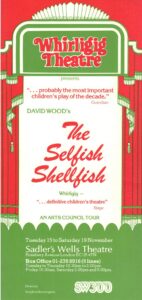 The play we chose was The Selfish Shellfish. This was the first overtly environmental play I had written. Set in a rock pool, featuring a cast of shellfish characters, the play had first been commissioned by Stephen Barry, the Artistic Director of the Redgrave Theatre, Farnham, where the play was first performed in March, 1983. Stephen directed it himself, very well, and we got some lovely reviews. It felt right to put on a Whirligig production only a few months later, and we decided to bring in the usual team – Susie, Sheila and Peter to create a new production, which I directed.
The play we chose was The Selfish Shellfish. This was the first overtly environmental play I had written. Set in a rock pool, featuring a cast of shellfish characters, the play had first been commissioned by Stephen Barry, the Artistic Director of the Redgrave Theatre, Farnham, where the play was first performed in March, 1983. Stephen directed it himself, very well, and we got some lovely reviews. It felt right to put on a Whirligig production only a few months later, and we decided to bring in the usual team – Susie, Sheila and Peter to create a new production, which I directed.
For the first time we employed a Casting Director, the excellent Sheila McIntosh, who introduced us to several actors we might have ‘missed’ without her expertise. Melody Kaye, Caroline High and Richard Sockett returned to us, and David Learner (Seagull), Bernard Finch (H.C) and Bill Ritchie (The Great Slick) were newcomers. An excellent new find was the Assistant Stage Manager, David Bale, who also played the part of Sludge. David became a Whirligig regular in years to come. Bill Bray returned to do the lighting. Paul Farrar came back to do the sound. Paul Knight returned as Musical Director. What was really encouraging was how many of our personnel seemed to enjoy coming back for more!
Although I had been considering a more meaty subject than usual, something with a significant moral dilemma, with which to challenge our young audience, I was not really intending to create a play that combined the elements of children’s theatre and those of Theatre In Education. But I suppose that is what I was doing. But I certainly didn’t want to let the tail wag the dog – I felt it was wrong for teachers and educationalists to set the agenda for the content of a children’s play. Indeed, I had been approached by a teacher trying to persuade me to do a play about water, because it was on the curriculum. This was not what I wanted to do. I wanted to give the children a theatrical experience that was not necessarily directly linked to their education syllabus.
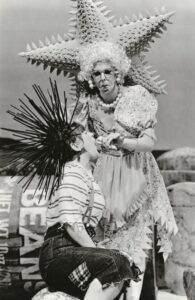
Strangely, the idea for The Selfish Shellfish did not come from a desire to explain to children the dreadful effects of oil spillage and pollution. For some reason I suddenly had a vision of an actor wearing a cloak, so big that it would cover the entire stage. This theatrical image was very appealing, and I tried to imagine what character might be thus portrayed. An oil slick seemed to be an interesting thought. This led to the creation of the play, in which The Great Slick comes to invade the rock pool and thereby kill all its inhabitants. The audience had fun creating a storm with which to frighten off the monstrous Slick. I was aware that this was not a real possibility, rather a theatrical fantasy solution to a problem, but reckoned that it was enough to sow the seeds of the oil pollution problem in the minds of our young audience, who would not take literally the possibility that pretending to be a storm could affect the power of Mother Nature …
We opened successfully at the Civic, Darlington and then played the New Theatre Cardiff, Festival Theatre Paignton, Empire Theatre Liverpool, Towngate Theatre Basildon, Palace Theatre Manchester, Buxton Opera House, Sadler’s Wells, New Theatre Hull, Alexandra Theatre Birmingham, Bristol Hippodrome and the Oxford Playhouse.
1984
There was quite a lot of interest in The Selfish Shellfish, enough to make us consider the idea of touring, for the first time, in the Spring of the following year. We reckoned that with a few reasonable guarantees, we could make another tour of up to ten weeks just about pay for itself, especially if we received a small subsidy from Arts Council Touring. In the end, we requested just £5,000.
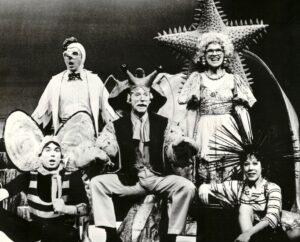
For the second tour, as well as the first, we organised as much schools liaison as was possible. Eileen Oliver was employed to do the work, as well as to sell relevant merchandise in the foyer. The theme song of The Selfish Shellfish was called When Will We Learn? and became popular with schools. It also, for a time, became the anthem of Friends of the Earth. We sold copies of the sheet music plus a 45 rpm record.
For this tour, Lucy Fenwick took over the role of Starfish and Wenda Holland returned to the company as Urchin. Ian Cross played Seagull and Colin Wakefield played The Great Slick. Colin was to return to Whirligig later that year, before going on to write extremely successful pantomimes. Our rehearsals were helped by the fact that we could use the set, which was erected on the stage of the Questors Theatre, Ealing.
A particular pleasure for me was taking the play to Chichester Festival Theatre, where I had been an extra in the second season in 1963. I had been at school in Chichester and my old English master, who was a considerable influence, was the secretary of the Friends of the Festival Theatre. It was a real pleasure to make contact with him again, and also Geoffrey Marwood, one of the two masters at school who had directed me in several school plays.
The Spring tour, 1984, of The Selfish Shellfish opened at the University of Warwick Arts Centre, then played Chichester Festival Theatre, Theatre Royal Bath, Theatre Royal Glasgow, Kings Theatre Edinburgh, Palace Theatre Newark, Richmond Theatre, Theatre Royal Brighton, Grand Theatre Swansea and the Grand Theatre Leeds. The quality of this list of number one theatres (or, at least, most of them) shows how Whirligig’s credibility had increased, and how more mainstream theatres were willing to introduce children’s theatre to their programming. Interestingly, Clarks Shoes very kindly gave us £3,000 towards our week in Bath, which was not far from their offices and factory in Street, Somerset. We enjoyed working with them again. American Express gave us £750 towards our week in Brighton. But finding a new major sponsor for Whirligig was becoming problematic. Our relationship with Clarks had been headline news. Other sponsors were reluctant to work with us, because they felt that the word ‘Whirligig’ was almost indelibly linked to Clarks Shoes.
The Spring tour lost nearly £1,000, but we were delighted that, following the loss of Clarks support, we had managed to keep going.
One thing that helped us balance the books was the fact that I was writing and directing the plays, and could always waive my royalties, when they were needed to subsidise the production. This became a regular happening, which I never resented because the touring success of the company was more important to me, and also because some my plays were beginning to be recognised and performed by other companies, both professional and amateur, which helped pay the rent!
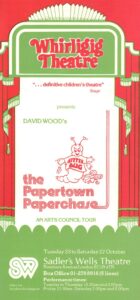
For the Autumn 1984 tour, we wanted to do a somewhat larger production than The Selfish Shellfish, mainly because we were now playing in more theatres seating 1,000 or more. The play I suggested, and John agreed to, was The Papertown Paperchase, the play I had originally written as the 1972 Christmas production at the Swan Theatre, Worcester. Samuel French had published the play, but I had always had my doubts about its structure. The story follows a struggle between the Land of Fire and the paper citizens of Papertown. There is a Beauty and the Beast element, in which a young Salamander, who has failed his fire-breathing test, kidnaps young Tissue. Fireman Silver (made of silver paper that does not burn) leads the quest to rescue Tissue, accompanied by a kind of comedy double-act, Carbon and Blotch. Having seen the original production, I felt that the action went backwards and forwards between the two lands too many times. And there were several scenes that were too wordy. But I was confident that it was possible to re-work the play for a Whirligig production, and, as I was directing it too, I felt I could build on the success of the initial production. It proved an ambitious choice. A large cast, many costumes, several sets, including moving trucks. But it proved to be one of our most spectacular shows, beautifully lit by Bill Bray, and one that yielded a tremendous response and passionate audience participation.
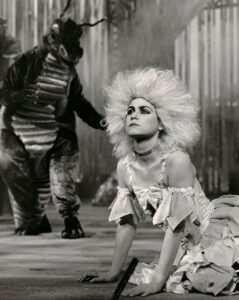
Colin Wakefield, David Bale, Shaun McKenna and Mike Elles returned to the acting team, along with three new talented female recruits, Sophia Winter (who later worked for Alan Ayckbourn and at the National Theatre before tragically dying of an ectopic pregnancy), Jane Whittenshaw (later a very successful radio actress) and Shannon Sales.
The Salamander was really a ‘skin’ role, needing excellent mime skills. Paul Aylett did a splendid job. His main career as a puppeteer had been effectively employed the previous year, when he designed the amazing, long-armed Great Slick. Susie, Sheila and Peter all returned and did their usual excellent work. Chris and Kevin were again our Company and Stage Manager. Carrie Bayliss once again supervised the wardrobe. The touring wardrobe mistress was the highly efficient Kathy Butterly, fresh from a stint on Les Misérables. The two ASMs, who both were in their first jobs and acquiring their Equity cards via Whirligig were Lisa Bowerman, who later combined her acting with a very successful photographic career, and Howard Leader, who went on to considerable success as one of Esther Rantzen’s reporters on the television programme That’s Life.
Funding this year proved problematic. Arts Council Touring offered us a £40,000 guarantee against loss, which was less than we had asked, but still positive. Sponsorship, however, proved virtually impossible. We had a regretful letter from Malcolm Cotton, the Managing Director of Clarks mid-August, saying they couldn’t help at all. Remarkably, a couple of weeks later, they generously offered us £2,500 towards our week at the Bristol Hippodrome. We gratefully accepted. BP Chemicals responded positively to one of our many letters appealing for sponsorship, but disappointingly only offered £25. Bill Kallaway tried hard, but failed to achieve a major sponsorship. Again, it seemed that Whirligig’s name was linked so closely to Clarks that potential sponsors were put off.
Somehow John managed to balance the books, against all the odds.
In spite of the fact that we had no sponsor to provide a giveaway for every child, we managed to produce a free programme, which incorporated a board game based on the play. And, for the teachers, we provided Project Fire, an interesting bundle of documents for schools’ use, produced by the Home Office. We had realised that, as one of the themes of the play was fire, we could promote the educational value of learning about the dangers of fire, fire prevention etc. Eileen Oliver returned to look after schools’ liaison.
The Papertown Paperchase played for eleven weeks. We opened at the Civic Darlington, and then played the Empire Liverpool, Gordon Craig Stevenage, Bristol Hippodrome, Sadler’s Wells, New Theatre Hull, Buxton Opera House, Birmingham Hippodrome, Theatre Royal Nottingham, Grand Theatre Swansea and the Oxford Playhouse.
1985
For the Autumn tour, 1985, we thought that Meg and Mog Show might be a good idea. My adaptation of the Meg and Mog books had been first produced by Unicorn Theatre in 1981, and had been revived successfully. We thought that we could keep our production costs down by touring this production, which had never been seen outside London.
However, this was not to be. We still had major problems with sponsorship.
The Arts Council eventually came up with £42,000, which helped considerably. But we needed to find enough guarantees from a dozen theatres to ensure we could break even.
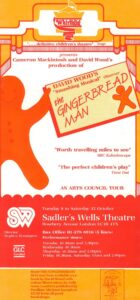
Because of this, we decided to offer The Gingerbread Man. Since the first production of my play in 1976, at the Towngate Theatre, Basildon, Cameron Mackintosh and I had produced it twice at the Old Vic and subsequently toured it a couple of times. But the play had not been seen in the regions for some years and theatres were keen to book it, and to give a reasonable guarantee. This meant that our need for sponsorship was, if not removed, certainly lessened. Thanks to Laurence Harbottle, our solicitor, we received £500 from St James Productions, but nothing else.
Susie and Peter returned, having both worked on The Gingerbread Man before, and Sheila Falconer choreographed it for the first time (not the last!). Robert West, Cameron Mackintosh’s legendary Company Manager, had also worked on The Gingerbread Man before, and very effectively lit the production for us.
Mike Elles and David Bale returned to the acting company, along with new faces Susannah Bray (who was to become a regular), Philip Eason, Pepsi Maycock and Colin Hurley, who later did great work at Shakespeare’s Globe Theatre. Stuart Pedlar joined us as Musical Director.
We played Theatre Royal Newcastle, Civic Darlington, University of Warwick Arts Centre, Sadler’s Wells, Kings Theatre Edinburgh, His Majesty’s Theatre Aberdeen, New Theatre Hull, Grand Theatre Swansea, Birmingham Hippodrome, Palace Theatre Newark, Buxton Opera House, Grand Opera House Belfast and the Oxford Playhouse.
Jodi Myers had taken over from Ruth Marks at Arts Council Touring. She became a sympathetic supporter.
The Gingerbread Man was then offered a London Christmas season at the Bloomsbury Theatre, which we felt able to take on, because the tour was virtually guaranteed to break even. The London season was successful, and led to Channel 4, the television channel, commissioning a television production of our stage production, which was recorded in a studio, complete with live audience, and screened at Christmas 1986.
Net box office receipts for The Gingerbread Man tour and Christmas season exceeded £140,000. Our share did indeed cover the costs of the tour.
Every child in the audience received a free programme, containing a board game based on the play.
Although The Gingerbread Man was a ‘smaller’ show than Whirligig’s usual productions, the set – an antique Welsh dresser on a giant scale – seemed to fill the stage wherever we played. This always intrigued me, because it was exactly the same set, not just the same design, the same physical set we had originally used at the Towngate, Basildon, which had a very small stage. The same set seemed to work absolutely fine in the large theatres, which was a considerable relief. It also meant that in years to come, whenever there was a financial problem for Whirligig – and, indeed, Unicorn Theatre – The Gingerbread Man would ride to the rescue!
1986
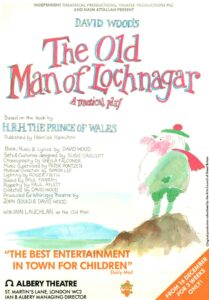
1986 proved to be a rather special Whirligig year, although it was also fraught with difficulty! Over a period of about 2 years I had tried to secure the stage rights of The Old Man of Lochnagar, the children’s book written by HRH The Prince of Wales. This involved meetings with the Prince’s Private Secretary at Buckingham Palace, although I never met the Prince himself. Having provided a synopsis, the Palace informed me that I must write the play and submit it, before any rights could be given or plans made for a production.
I delivered the play, which I felt was faithful to the book, although it developed considerably the characters and created a more theatrical and, in some ways, logical plot. Prince Charles had clearly been influenced by his favourite radio characters, The Goons. This led to the creation of some delightful characters, including the Gorms (from the Cairngorms) and Lagopus Scoticus, a Scottish Loch equivalent of the Old Man of the Sea. The somewhat anarchic events that affect the Old Man of the title are somewhat episodic, so I needed to create a through storyline.
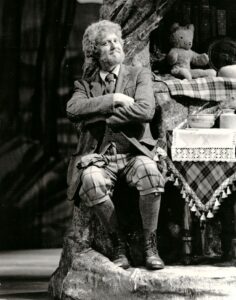
The extraordinary Peggy Ramsay, who was my agent, although Tom Erhardt did most of the work on my behalf, agreed to read the play, just in case it needed to be changed before being delivered to the Palace. She phoned me and said that she felt the second half was better than the first. She also said that I probably ought to remove the lavatory … when I pointed out that the Old Man’s special lavatory, that could be flushed by pulling on one of the pipes of a set of bagpipes, was featured heavily in the book, Peggy immediately cried, ‘Oh well, that’s fine, dear!’ and put the phone down.
The play was accepted without any requests for re-writes. To this day I have no idea whether Prince Charles actually read it. He certainly never came to see it, nor did any members of his family. This was a shame, partly because I would have liked him to see it, but also because we never benefited from the publicity a visit from him would have brought us. We had gone to the trouble of opening the production at His Majesty’s. Aberdeen, the nearest theatre to Balmoral, where we knew the Royal Family would be staying for the summer holidays. The local press became very excited and forced one of their photographers to virtually camp on the front steps of the theatre, just in case HRH suddenly arrived. Perhaps the newspaper only had one photographer, because they didn’t cover the photo call we organised – their man and his camera were resolutely standing by outside …
The files relating to The Old Man of Lochnagar are mainly housed by Seven Stories in Newcastle. They house most of my writing archive, including the original manuscripts of my plays. However, for some reason I must have included all the Whirligig documents relating to the production of The Old Man of Lochnagar play.
So it is in the Seven Stories archive that the run-up to the opening of the production can be found. This includes financial information, showing how tight things were budget-wise. When we approached Arts Council Touring with the proposition of doing, for the first time in history, a theatre production featuring a member of the Royal Family on the poster, we were greeted with delight by Jodi Myers, who somewhat horrified us by saying that this would obviously mean we would not be looking for any subsidy from the Arts Council this year. She assumed that the royal connection would bring corporations and commercial companies rushing to our door with offers of sponsorship, in return for getting commercial benefit for their organisation. Alas, this was not to be. We received no sponsorship whatsoever for The Old Man of Lochnagar. Perhaps the sponsors were frightened off by the royal connection. Perhaps they felt that their publicity opportunities would be limited. So, although Kallaway tried hard, we had to try to make the show work using just the Arts Council Touring subsidy. Susie’s set had to be cut down. Theatres had to be begged for increased guarantees. The Whirligig team worked incredibly hard to help balance the books, and we did indeed scrape through, in spite of the fact that we didn’t achieve huge audiences. Whether this was due to school teachers exercising a republican resistance, or whether they didn’t like Prince Charles’s book, we never knew. But audience figures went down.
The reviews were very good, enough for Howard (later Sir Howard Panter of the Ambassador Theatre Group) to invite us to play a short Christmas season in the West End. We were thrilled to be playing at the Albery Theatre, on top of an evening show featuring the comedian Dave Allen. Unfortunately our arrival was announced very late in the day so, in spite of a lot of press coverage, business wasn’t great. And nobody from the Royal Family attended.
The fact that we were at the Albery Theatre was of particular pleasure to me, because it was the theatre at which I had seen Oliver! when I was at the highly impressionable age of about 15. The theatre was then called the New Theatre. It was the first time I had been allowed to come to London on my own. I sat on a little stool in the alleyway alongside the theatre, bought my balcony seat, then spent the rest of the day visiting magic shops, before returning to see Ron Moody and Georgia Brown, as Fagin and Nancy, giving two of the greatest performances I had – and have – ever seen.
The original book, The Old Man of Lochnagar, was illustrated by the architect, Sir Hugh Casson. We asked permission to use an image from the book for our poster, as well as his idiosyncratic lettering. He kindly agreed, and indeed came to see the show! He sent me a delightful letter of thanks, incorporating a hand drawn cartoon of the Old Man.
John Craig of First Night Records offered to record the story and songs of the play. Iain Lauchlan, who played the Old Man, narrated. The cast, including Mary Ann Coburn, sang the songs, and the recording was released on cassette. Amber Lane Press published the play before the production opened.
Just before the end of our West End run, Channel 4 agreed to commission a television version of the stage production, to be filmed at the Albery Theatre at the end of the run (I remember it was snowy and icy and everyone stayed in hotels to make sure they didn’t get stranded outside London) and to be screened the following Christmas. Verronmead Ltd., the small television company I ran with Maureen Harter, had previously filmed The Gingerbread Man for Channel 4. Now there was a follow-up, which we hoped might become part of a series. The programme went out, splendidly directed by Dave Heather, who had also directed the tv production of The Gingerbread Man, with the logo Whirligig Children’s Christmas Playhouse before the main title. Alas, we were never invited to translate another Whirligig production to the screen …
The tour list of theatres reflected the prestige of presenting a play with a Royal connection, and also showed how we had progressed in the seven years since Whirligig had started. We were playing in top mainstream theatres, on our own, with no other show playing in the evenings. A tour like this would have seemed impossible only ten years earlier.
After opening at His Majesty’s Theatre Aberdeen, we played Kings Theatre Edinburgh, Civic Darlington, Theatre Royal Plymouth, Palace Theatre Manchester, Theatre Royal Nottingham, New Theatre Hull, Theatre Royal Norwich, Derngate Northampton, Birmingham Hippodrome, Arts Theatre Cambridge, Buxton Opera House, Oxford Playhouse, and then to the West End, to the Albery Theatre for a three week season.
1987
The Old Man of Lochnagar must have increased Whirligig’s visibility and credibility. The royal connection, the West End season and the increased media profile we had experienced led to the Arts Council giving us more towards our 1987 tour than ever before. There was a meeting with Jack Phipps, the Head of Touring, Jodi Myers, Sian Ede and Richard Johnston, representing the Touring Panel, at which it was suggested that money should be found to employ a Primary Schools Theatre Liaison person. The estimated cost was £6,000. Arts Council Touring offered to find half, if Whirligig could find the other half. Cameron Mackintosh generously donated £3,000 and the appointment could therefore be made. Jessamy Hadley started working with us on July 6th, and became a great help in working more closely with the schools than Eileen Oliver and I had ever had the time to do. We also had pointed out to the Arts Council that we still had no office. I was responsible for booking the tour, assisted by Barbara Scott (Shipton). John was still responsible for the financial side. We still had no administrator.
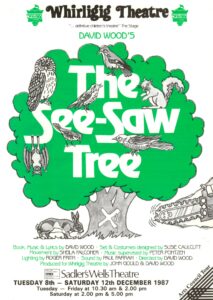
The Arts Council came up with £60,000 for our tour of The See-Saw Tree. This enabled us to once again employ Ben Forster as my assistant director. Ben had been with us for the last two years, but paying him had been a problem. I had donated some of my director’s fees towards his fee. His contribution had been considerable, and I much welcomed his input. He had recently directed, on his own, the 10th anniversary production of The Gingerbread Man, back at Basildon Towngate Theatre, and had done a splendid job.
The See-Saw Tree had been originally commissioned by the Redgrave Theatre, Farnham. Stephen Barry who had commissioned The Selfish Shellfish, had kindly asked for another play, which was given its premiere in 1986. The production had been well received. Alex Kingston, later to become an extremely successful actress, played Dunnock. The play was another environmental one, about the possible felling of a historic oak tree. The idea for the play, or at least a play about trees, had come from an environmental charity called Common Ground, who were organising a Year of the Tree. They approached me and I tried to come up with a story that would be strong in itself as well as promoting the message that trees were a vital part of our lives.
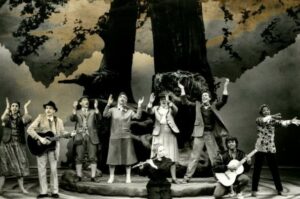
Choosing The See-Saw Tree for our 1987 tour seemed a good idea, although it has to be admitted that some of our regular theatres were now wanting a slightly more commercial title. For me as a playwright, the joy of Whirligig had been that schools, once they trusted us, would bring parties to see plays with unfamiliar titles. The Selfish Shellfish and The Papertown Paperchase had done as well as the more familiar titles like The Owl and The Pussycat went to See… and The Gingerbread Man.
This year’s tour list began with University of Warwick Arts Centre, where we opened, Civic Theatre Darlington, Theatre Royal Bath, Richmond Theatre, Grand Theatre Swansea, Grand Theatre Wolverhampton, Princess Theatre Torquay, Palace Theatre Newark, Buxton Opera House and Sadler’s Wells. The tour was shorter than usual.
Another factor was that by now a number of companies more commercial than Whirligig had noted our existence and were touring children’s shows based on television characters. The theatres, or some of them, were undoubtedly being tempted to take the more commercial option. But our regulars continued to support us. Oxford Playhouse had just closed its doors, unfortunately, so our regular sell-out week was not on the list.
Before the tour opened, Arts Council Touring invited us to write about our aims for the future, in particular the 1988/89 season, Whirligig’s 10th annual season. We told them we hoped to introduce a ‘Day In The Theatre’ scheme, whereby school children could come and see the play, as well as be introduced to theatre in general, with demonstrations of lighting, sound, make-up etc.
We also expressed our hope of being able to employ a full-time administrator, and to eventually produce two tours a year, one of which would be a new one, specially commissioned or ‘found’, hopefully by a new writer, or by an established writer new to Whirligig. At least one of the two tours would be directed by a director other than me.
The last two points were made in response to a criticism that Whirligig was really a showcase for plays by David Wood, directed by David Wood. I had to admit that this appeared to be the case, but pointed out that we had never had the money to commission or develop new plays by anyone else, that I co-ran the company for little financial reward, and often donated my royalties to make up shortfalls in the budget or end-of-tour accounts. If, we argued, we had proper funding, we could expand the company and introduce plays by other writers directed by other directors.
The See-Saw Tree at Sadler’s Wells benefited from our use, for the first time, of a telephone sales person, calling up schools and talking about the show. This was an experiment, but, to our surprise, we found that a lot of schools responded positively. We had thought they might resent the cold calling, but this was not the case. Several asked to be reminded each year of Whirligig’s regular slot at Sadler’s Wells, asking for details months ahead, so that they could plan a visit.
It may be worth noting that we had originally hoped that The See-Saw Tree might tour throughout the autumn of 1987, play a Christmas season somewhere, then continue touring into the Spring of 1988. 20 weeks in all. This proved impossible, and we had to scale back. But the tour received great reviews and our Sadler’s Wells week was a triumph. We finished the tour there, and I remember addressing the cast rather tearfully – unusual for me, because although I am passionate about what I do, I don’t often get sentimental about it – thanking them for showing the powers-that-be exactly what Whirligig could do – a play for children that was both entertaining and ‘educational’, taking a serious theme and telling the story seriously, without any patronising of the audience or compromise in quality of the physical production. I was very proud of this production and of the company.
The 1987 tour of The See-Saw Tree produced two fairly extreme examples of how difficult we found it to play on top of an evening attraction, even when all the details had been agreed in advance with the other management and with the theatre.
At the Theatre Royal, Bath, we were playing on top of an amateur production of West Side Story. It turned out that a local lighting hire company had kindly donated equipment to the amateur company, with the result that our Company Manager had never seen such a huge lighting rig in his life. Every position on every bar was taken. There was no room for any of our ‘specials’. Reaching a compromise was extremely difficult, and the afternoon before we opened I was rung up, in the middle of a book signing(!) in York, by Stephen Barry, who had very recently left Farnham and was now running the Theatre Royal, Bath. He complained that Chris Stringer, our Company Manager, was being aggressive. In fact, I’m sure that Chris was just fighting our corner! In the end, a certain compromise was reached, but much of our set, including the large, revolving tree itself, had to be accommodated in a pantechnicon outside the back of the theatre after every performance, because there was no room to store it backstage.
It was even worse at Richmond Theatre, where the play that had been booked to play alongside us had a rather delicately constructed conservatory as part of its set. We had signed our contract many months before. But, when the other play was contracted, we were asked if we might mind transferring our production to a tent on Richmond Green, to avoid the problems of the turnaround between the two shows. We refused to go in a tent and, at the get-in, the stage management of the other show appeared to be attempting to prevent our team and the theatre crew putting up our set! In the middle of the night it is rumoured that the police had to be called to avoid a scuffle. Needless to say, the Whirligig team made every effort to help the turnaround between our matinee performances and the other show’s evening performances, and it all worked out in the end. But it was very noticeable that the children’s show was viewed very much as the junior partner.
It reminds me of another occasion when Whirligig was on top of a big musical in a major regional touring theatre. We were told we could not use any dressing rooms, because they were all full. Our company had to change into costume behind screens erected, believe it or not, in the orchestra pit. Even when dressing rooms were allocated to the Whirligig company, if there was an adult show on in the evening, you could guarantee that the Whirligig actors would be in the dressing rooms right at the top of the building!
1988
At the beginning of 1988, things were looking pretty rosy. Our 10th anniversary touring season was approaching. The Arts Council had reacted favourably to The See-Saw Tree and to our future aims. Furthermore, with the closure of the Oxford Playhouse, Barry Sheppard, who ran it, no longer had a job. Barry had been a huge supporter of Whirligig, and our tours had regularly sold out ten performances. We contacted him to see what his plans were, inviting him to become Whirligig’s administrator. At this stage, John and I didn’t quite know how he would be paid, but it just seemed a perfect fit. Barry not only responded positively, he told us that he could work for Whirligig for 18 months without being paid! His contract with Oxford University, who owned the Playhouse, was that he would continue to be paid by them for 18 months. Barry generously offered to work from home, like John and myself, and to help plan the 1988 tour, and to also help us plan ahead.
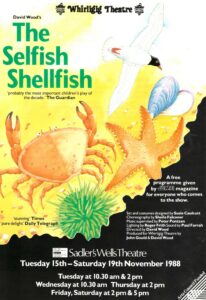
However, the first half of 1988 proved to be extremely difficult. On June 6th I wrote to all our Artistic Associates (Susie, Sheila, Peter, plus our accountant Jon Catty, our solicitor Laurence Harbottle, lighting associate Steve Kemp, Jonathan Lynn, Cameron Mackintosh and Robert West):
The last five months, as many of you know, have been something of a nightmare. However, we are now in a position to let you know our programme for the autumn. We enclose a schedule, showing that we will be reviving The Selfish Shellfish on tour, and presenting the professional world premiere of Dinosaurs and All That Rubbish at three venues (Darlington Arts Centre, Grand Theatre, Swansea and Sadler’s Wells Theatre, London), featuring a professional cast augmented by 100 local children!
Sadly, the euphoria we experienced at the end of the last year, when Arts Council Touring expressed pleasure in our work and a desire for us to develop the company, has diminished. We now find ourselves in the position of announcing that the forthcoming tour, our tenth annual tour, will be Whirligig’s last.
To elaborate, here is the story put as succinctly as possible!
At the end of last year, Arts Council Touring asked us to develop the company. We suggested that we’d tour two productions, one on top of the other. A revival of The Owl and The Pussycat went to See… plus Dinosaurs and All That Rubbish. This combination would hopefully encourage major theatres to take us for a whole week on our own. Owl had a strong commercial title, and could play a few evening performances. Dinosaurs could play three morning performances. Therefore, we were offering a full programme of 12 or 13 performances, plus the chance to involve the local community in performing in Dinosaurs.
Arts Council Touring applauded the idea and actually gave us figures with which to work – the first time ever this has happened! A total sum of £88,000 was intimated, though not promised of course.
At round about this time, we were fortunate enough to secure the services of Barry Sheppard, on secondment – free of charge to Whirligig – from Oxford University for 18 months. Barry, John and I worked hard on our figures, and succeeded in making them work. We also prepared budgets, as requested by Arts Council Touring, for a possible Christmas season of Owl, followed by a possible extension of the tour of both shows into the Spring. The three options were sent to Arts Council Touring in time for their February meeting.
We were stunned when the news came back that we were to be offered £70,000 only. Sadly, Arts Council Touring did not have enough money to offer us, and hoped that we could do something interesting for £70,000.
We adjusted the tour, cutting it slightly, and, having secured a gift of £5,000 from Cameron Mackintosh, plus a guarantee of £5,000 from David Wood, went back to Arts Council Touring, saying that we would offer them this revised programme for £70,000 but would ask for an extra £5,000 towards schools’ liaison, which was going to be so vital in setting up the children in the various venues.
Arts Council Touring said they would put the £5,000 question to the Projects Committee, and eventually this was forthcoming.
But, in the meantime, three venues dropped out of the tour. At Wolverhampton we were gazumped by the RSC; Buxton Opera House opted for Vanessa Ford’s Winnie The Pooh rather than us (after 9 year’s successful visits) and Edinburgh Kings simply dropped out without any explanation. All these were major guaranteed dates, and their loss put the whole tour in jeopardy.
Reluctantly, we decided to change our plans again.
At about this time, we had another letter from Arts Council Touring, which again was rather surprising, in fact, distressing too. We were informed that there would be no guaranteed funding from Arts Council Touring in the future. Arts Council Touring only fund on a project-by-project basis, and it was felt that Whirligig had been very fortunate to be funded so regularly over the years, and that Arts Council Touring must be free to support other touring ventures in the future.
The incentive to develop the company requested by Arts Council Touring only months earlier, now seemed to have disappeared. Dinosaurs was part of the development, but rather an expensive ingredient. To accommodate the new financial situation with the loss of the three theatres, we decided to cut Dinosaurs and simply do a revival of The Owl and The Pussycat went to See… which, we felt, was a good production with which to wind Whirligig up – historically the wheel had come full circle and we certainly felt we could not continue with Whirligig without Arts Council funding, let alone without sponsorship!
The news was greeted with disgruntled reluctance by Arts Council Touring, who said we could go ahead with Owl, but we would have our funding reduced if we did!
Back to square one. The decision was finally taken to scrap Owl (scrapping with it all the publicity design which had been kindly donated by Jump magazine), and to revive a smaller production, The Selfish Shellfish, restoring to the tour, but at a reduced number of venues, Dinosaurs And All That Rubbish.
We feel that, unless a miracle occurs, Whirligig cannot continue. Our dream that it might become a company along the lines of Cambridge Theatre Company is not possible without a very considerable injection of cash via the funding bodies or business sponsorship.
By a happy coincidence, however, we have had an approach from the Cambridge Theatre Company to mount a co-production with them in the autumn of 1989. We will naturally be pursuing this possibility.
We released a certain amount to the press, and there were reports that Whirligig’s forthcoming tour would be the last. Many supporters, including actors who had worked for the company, wrote, expressing their dismay.
However, the 1988 tour of the two shows was in many ways very successful and rewarding. Caroline High returned to the cast of The Selfish Shellfish, Mike Elles played HC, the Hermit Crab, Neil Smye, who had understudied the Gingerbread Man in 1985, was a delightful Seagull. Eric Potts, who later became known on Coronation Street and as a brilliant pantomime dame, was The Great Slick, Adrian Phillips played Mussel, Salli Randi was Urchin, and, making his first appearance with Whirligig was Adam Stafford. Adam had been a successful child actor, playing Michael in the Danny Kaye tv production of Peter Pan. He auditioned brilliantly, so it was with some embarrassment that we asked him to understudy and to play the small role of Sludge. But he accepted, and proved worth his weight in gold. He later became my assistant director, and acted in many of my plays, including Whirligig productions. For Dinosaurs we were lucky to secure the services of Peter Duncan, well-known ex-presenter of television’s Blue Peter. He had already played the Gingerbread Man in a London production, and was, of course, extremely popular with the school children taking part in the show. He was joined by Shelaagh Ferrell, who had once played Pepper in The Gingerbread Man, and whose musical skills and lovely, clear speaking voice, were perfect for playing the narrator, as well as the Chief Dinosaur.
Rehearsals were quite complex. Ben Forster directed Dinosaurs alongside choreographer Sheila Falconer. And Peter Pontzen was musical supervisor, with John Jansson as Musical Director/Keyboards. They worked with teachers, who helped to prepare the children in Darlington, Swansea and London. Meanwhile, rehearsals for The Selfish Shellfish were taking place in London.
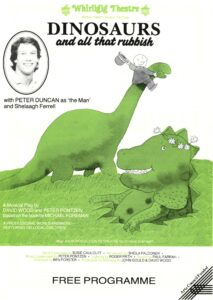 Susie designed Dinosaurs, to fit on top of The Selfish Shellfish. This worked extremely well. She also designed wonderful animal and bird costumes for Dinosaurs. The book, Dinosaurs and All That Rubbish, was written and illustrated by the brilliant Michael Foreman. In 1985 I was reading the story for the first time as a bedtime story to my daughter Rebecca, when I realised it would make a wonderful stage musical. I immediately rang my colleague from university days, Terry Jones, whose Fairy Tales Michael had illustrated, and asked him for Michael’s phone number. Within a very short space of time, I had the stage rights. A few months later, I was invited to write a play to celebrate a major anniversary at Howell’s School, Denbigh in North Wales. This happened to be my wife’s school. The play had to involve every single child, in acting roles, in the choir, or in the orchestra or in stage management. The splendid production, by Wendy Grey-Lloyd, was performed in 1986. Whirligig’s production was the first professional one, employing two professional actors with a large cast of children.
Susie designed Dinosaurs, to fit on top of The Selfish Shellfish. This worked extremely well. She also designed wonderful animal and bird costumes for Dinosaurs. The book, Dinosaurs and All That Rubbish, was written and illustrated by the brilliant Michael Foreman. In 1985 I was reading the story for the first time as a bedtime story to my daughter Rebecca, when I realised it would make a wonderful stage musical. I immediately rang my colleague from university days, Terry Jones, whose Fairy Tales Michael had illustrated, and asked him for Michael’s phone number. Within a very short space of time, I had the stage rights. A few months later, I was invited to write a play to celebrate a major anniversary at Howell’s School, Denbigh in North Wales. This happened to be my wife’s school. The play had to involve every single child, in acting roles, in the choir, or in the orchestra or in stage management. The splendid production, by Wendy Grey-Lloyd, was performed in 1986. Whirligig’s production was the first professional one, employing two professional actors with a large cast of children.
We played The Selfish Shellfish at the University of Warwick Arts Centre, Civic Theatre Darlington, Norwich Theatre Royal, Grand Theatre Swansea, King’s Theatre Glasgow, Sadler’s Wells, Palace Theatre Newark, New Theatre Hull and the Princess Theatre Torquay.
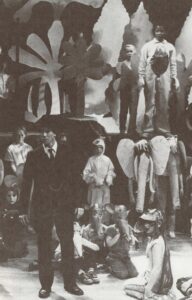
Dinosaurs played first at Darlington Arts Centre, then played on top of The Selfish Shellfish at Swansea and at Sadler’s Wells.
The report I made to the Artistic Associates reminds me of another example of how children’s theatre is often consigned to the second or third division, even when such an attitude is not intentional.
We had been booked into the Grand, Wolverhampton, one of our regular dates, when suddenly they apologetically pulled out of the deal, even though a contract had been signed months before. The reason was that the Royal Shakespeare Company had decided to tour a production, and, encouraged by Arts Council Touring, the Grand, Wolverhampton were given the opportunity to take this prestigious production for a week – the very same week they had originally booked us! I could quite understand why they did what they did, but it made things very difficult for Whirligig, because we had, at very short notice, to find another date to fill the gap in the schedule. I went for a meeting at Arts Council Touring, to see if they could help us find another date. They didn’t hold out much hope. However, what really made me see red was a large chart on a board showing the developing touring programme for the RSC production that had gazumped us at Wolverhampton. When I asked exactly what this chart was doing, I was informed that Arts Council Touring had taken it upon themselves to actually book the tour for the RSC. Bearing in mind that this major organisation had a large staff, including many people who would be fully equipped to book a tour, and bearing in mind that Whirligig didn’t even have an office, let alone a big staff, it did seem ironic that Arts Council Touring were unable to help us find a week, while happily doing the honours for the RSC!
It was round about this time that children’s theatre companies began feeling the effects of the 1988 Education Reform Act. Kenneth Baker, the Education Minister, could surely not have meant one of his new laws to have the devastating effect it managed to create. The Act stated that education had to be free. Fine. Few people would disagree. But ‘free’ extended to school visits to museums, arts galleries or theatres. It was decreed that parents could not be asked to pay for these ‘extras’ unless they were told that their contribution was voluntary. It’s fairly obvious that a fair proportion of parents, if told that their contribution is voluntary, would decide not to contribute. And, indeed, this is what happened. Many trips were cancelled, because not enough parents coughed up. Many trips never got planned in the first place, in the knowledge that not all the money would be forthcoming.
The effects manifested themselves most noticeably on one of our Sadler’s Wells weeks. We had about 9,000 tickets pencilled, thanks to our telephone sales system, but a few months later, once the Act had taken effect, the numbers had gone down to 6,000.
It took several years for children’s theatre companies to recover from this Education Reform Act blow. In the end, although I think the law still stands, most teachers stopped bothering to tell the parents their contribution was voluntary, and things slowly returned to ‘normal’.
1989
But in 1989 the effects of the Education Reform Act were very visible. Barry wrote to Jodi at Arts Council Touring, explaining how volatile the situation was. There was, he said, ‘an enormous variation in reaction to the Act up and down the country; some areas seem to have worked out a satisfactory way of working within it, others appear not to have given it any thought as yet and have just stopped trips altogether, yet others are blithely carrying on as before!’
The fact that Barry was writing to Arts Council Touring shows that we had not completely given up. And, in fairness to Arts Council Touring, they did not abandon us completely, as had been suggested the previous year. In February, 1989, Jack Phipps wrote to Barry to confirm that they were willing to support a tour of The Ideal Gnome Expedition with a guarantee against loss of £47,500. Arts Council Touring expected a minimum of 8 weeks. The figure was to include 50% of the cost of the Schools Liaison post.
In his letter, Jack made it very clear that they were still unwilling to offer us regular funding. Also, he pointed out that there were other children’s theatre companies who might well want to tour. Furthermore, he said that they were ‘urging the existing companies to programme work for children’. In other words, regional theatres were to be encouraged to produce children’s theatre and then tour it. This plan seemed to us to be a strange one. The costs of preparing a children’s show for touring, rather than a resident season, would be considerable. Also, quality could not be guaranteed if the theatres were encouraged to put on children’s plays simply because they could get a bit of extra funding for so doing.
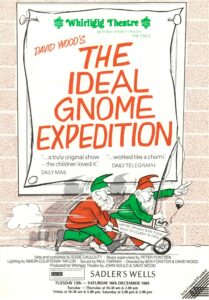 We had decided to revive The Ideal Gnome Expedition for several reasons. First, we still had the physical production in store. In fact Whirligig could not afford to rent a store, so I had decided to do it myself. Several sets were crammed into a storage unit near Doncaster. It made sense to re-use sets if and when we could.
We had decided to revive The Ideal Gnome Expedition for several reasons. First, we still had the physical production in store. In fact Whirligig could not afford to rent a store, so I had decided to do it myself. Several sets were crammed into a storage unit near Doncaster. It made sense to re-use sets if and when we could.
Furthermore, the television series, Chish ‘n’ Fips, based on The Ideal Gnome Expedition stage play had recently aired on Central Television (ITV) and become quite popular. A book version, in the form of an annual, was published, and an LP record and cassette of the songs released. Furthermore, I had written a new song for the television series called Big Ones Are You List’ning? This was an anti-litter song, in which the Gnomes complained about the amount of litter dropped by human beings. This song was not in the original play, but it seemed a very good way of making the play appeal more to schools – the anti-litter message was a powerful one. So I managed to insert the song into the show.
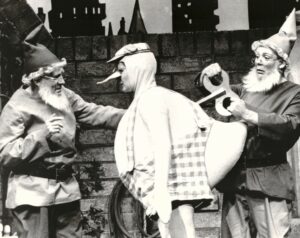 The regular team returned. Kevin Chadderton became Company Manager, joined by Gilda Frost as Deputy Stage Manager (on the book). Gilda became a Whirligig regular. Lighting was by Simon Courtenay-Taylor, who had previously worked for me on a production of Rupert Bear, for another production company. Rachel Corderoy, who, along with her twin sister, Jocelyn, both became regular wardrobe personnel, joined us this year, along with Isobel Nimmo, who was our Schools Liaison and Publicity person.
The regular team returned. Kevin Chadderton became Company Manager, joined by Gilda Frost as Deputy Stage Manager (on the book). Gilda became a Whirligig regular. Lighting was by Simon Courtenay-Taylor, who had previously worked for me on a production of Rupert Bear, for another production company. Rachel Corderoy, who, along with her twin sister, Jocelyn, both became regular wardrobe personnel, joined us this year, along with Isobel Nimmo, who was our Schools Liaison and Publicity person.
David Bale and Adam Stafford played the Gnomes, with Charlotte Knight as Baby Duck. David Burrows, who had started with us as an ASM on The See-Saw Tree, played Chips the Cat, and Aidan Bell played Securidog and Wacker.
Our Technical ASM was Neil Hillyer, another regular Whirligig stalwart. And, from Bristol Old Vic Theatre School, we discovered Clive Hayward, who became an ASM/understudy. Clive was an excellent member of the team, who later went on to considerable success as an actor and director.
Yamaha-Kemble sponsored a well-supported colouring competition, with 30 Yamaha keyboards as prizes.
We opened at University of Warwick Arts Centre, then played theatres including Civic Theatre Darlington, Buxton Opera House, Orchard Theatre Dartford, Theatre Royal Glasgow, Futurist Theatre Scarborough and a three week Christmas season at the Gardner Arts Centre, Brighton.
1990
With Barry on board, we were trying to think ahead as strategically as possible. We wondered about forming a charitable trust, to help find funding. We wondered whether we should continue to resist the idea of adapting well-known books, particularly in light of the difficulties created by the Education Reform Act. We realised that now there were more companies beginning to tour in the commercial sector. The titles they toured were all very well-known ones, either from books or television.
We were continuing to talk to Cambridge Theatre Company about a new play, and hoped we might do a deal with them whereby they produced the play in association with Whirligig, so that it could then tour.
We wondered about finding a ‘base’ theatre, from which we could launch new productions.
We wondered about commissioning a new play for 1991 from a well-known writer.
We wondered if we should be thinking internationally, with a view to touring plays in association with the British Council. We were very aware that, in order to develop the company, we needed to accept the fact that we could no longer rely on Arts Council Touring to fund us. And, sadly, sponsorship was still a major problem.
In January 1990, Barry wrote to Jodi Myers, Deputy Director of Touring at the Arts Council. He reported that the 1989 tour of The Ideal Gnome Expedition had done disappointing business. The average attendance had been 39%, compared with 67% the year before. We put this down almost entirely to the effects of the Education Reform Act.
But Barry was able to be more positive about our plans for the 1990 tour. Cambridge Theatre Company had, as hoped, commissioned a new play from me, to tour in the Spring of 1990. Then the idea was that Whirligig would tour the play in the autumn.
What was particularly pleasing was that Robin Midgeley, Artistic Director of Cambridge Theatre Company, not only commissioned the play, but asked me to direct it. This meant that the Whirligig team could all be involved – Susie, Peter, Ben (my assistant director), Sheila, Paul Farrah (designing the sound), plus the usual production team too, including Chris Stringer and Kevin Chadderton.
One splendid addition to the team was the legendary lighting designer Robert Ornbo. I had known him for some years, from when I was acting. I knew he lived not far from Cambridge, where the show was due to open, and I also knew he had specialist knowledge of slide projection, which was my staging idea for the production. Robert not only did a brilliant design, but did it using the simplest lighting rig we had ever had, saving us time at the fit-ups, yet losing no quality, indeed improving it.
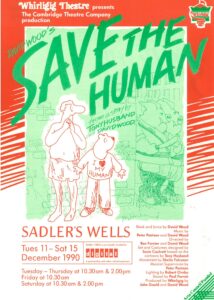 The play was Save the Human. This had started life as a book proposal. Tony Husband, a well known cartoonist, had won a competition. He was quoted as saying that he would like to work on a children’s book. I contacted him, we met, and very quickly started developing Save the Human, which featured role reversal. Animals have taken over the world, following the mistakes of human beings, with their wars, pollution and general carelessness. Becky Bear has a pet human, Norman, who is kidnapped by the Securipigs and taken to a research establishment run by Professor Rhino, where they do experiments on humans for the benefit of animals. Becky and her animal friends then try to rescue Norman. The story approached a serious subject in a novel way, particularly suited to Tony’s cartoon talents. But publishers turned it down.
The play was Save the Human. This had started life as a book proposal. Tony Husband, a well known cartoonist, had won a competition. He was quoted as saying that he would like to work on a children’s book. I contacted him, we met, and very quickly started developing Save the Human, which featured role reversal. Animals have taken over the world, following the mistakes of human beings, with their wars, pollution and general carelessness. Becky Bear has a pet human, Norman, who is kidnapped by the Securipigs and taken to a research establishment run by Professor Rhino, where they do experiments on humans for the benefit of animals. Becky and her animal friends then try to rescue Norman. The story approached a serious subject in a novel way, particularly suited to Tony’s cartoon talents. But publishers turned it down.
When Robin at Cambridge Theatre Company asked for a play, I spent a long time developing another idea, which never really worked. As the deadline approached, I suddenly thought of Save the Human, sent the manuscript to Robin, who immediately responded positively, suggesting I turn it into a play.
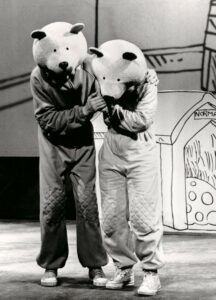
In many ways, Save the Human was the most inventive show Whirligig ever presented.
In spite of the fact that Arts Council Touring still made it quite clear that we could not expect funding every year, they responded to our application with an offer of £70,000. We received sponsorship from an American company, School Book Fairs, who gave us £7,500 to create free programmes, which were also face masks for the children to wear at one particular point in the performance.
Regulars in the cast included David Burrows, Adam Stafford, Wenda Holland, Neil Smye and David Bale. Newcomers included the splendid Jenny Galloway, who was an excellent Becky Bear. Jenny went on to have great success in adult musical theatre.
Business on the tour wasn’t brilliant, but the reviews were very good and we felt that we had developed as a company, particularly in the way a new physical theatre style evolved in rehearsal, mainly because we used helmet-style masks for the animal characters, allowing their faces to be seen, but with an animal head above. Most of the time the actors played in coloured tracksuits, which meant that they could become different characters simply by changing head dress. The slide projections of Tony’s cartoons created the locations extremely effectively.
We opened at the University of Warwick Arts Centre, then played Bristol Hippodrome, Sunderland Empire, Northampton Derngate, Wimbledon Theatre, Grand Theatre Wolverhampton, Princess Theatre Torquay, Grand Theatre Blackpool, Palace Theatre Newark, Grand Opera House York. Manchester Opera House, then Sadler’s Wells in the second week of December.
A pleasing postscript to the tour was that it resulted in Hamish Hamilton agreeing to publish the book that had been previously turned down. The wheel came full circle!
1991
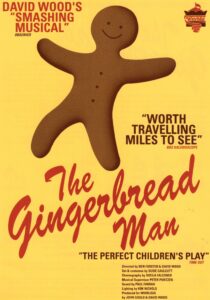 In 1991, as we planned our 13th annual tour, it became clear that there would be no money forthcoming from Arts Council Touring. Barry, John and I decided that our best plan was to revive The Gingerbread Man. This play had already been produced – in exactly the same production, using the same set – by Cameron Mackintosh and myself, by Unicorn Theatre, and by Cambridge Theatre Company. Of all my plays it was the one that seemed to guarantee reasonable business.
In 1991, as we planned our 13th annual tour, it became clear that there would be no money forthcoming from Arts Council Touring. Barry, John and I decided that our best plan was to revive The Gingerbread Man. This play had already been produced – in exactly the same production, using the same set – by Cameron Mackintosh and myself, by Unicorn Theatre, and by Cambridge Theatre Company. Of all my plays it was the one that seemed to guarantee reasonable business.
But we couldn’t go ahead without investment. We needed £80,000 to make safe the proposed tour. We approached artistic associates of the company, as well as other friends and professionals who knew our work, and were relieved – and grateful – to raise the full amount, though not always in conventional ways. Cameron Mackintosh and Eddie Kulukundis (Knightsbridge Productions) both generously invested £10,000. Apollo Leisure put in £7,500, as did the Theatre Investment Fund. Michael Codron helped, as did our accountant, and Michael Lyas, who ran Wimbledon Theatre. Dewynters agreed to do all our posters and leaflets, design and printing, for a notional investment of £10,000. Paul Farrah, our sound designer, who by now was running a successful lighting and sound hire company, put in another £10,000.
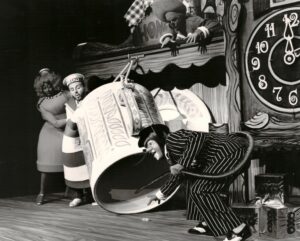
Not only that, all the creative team donated, or invested, their fees – Ben, Sheila, Peter and Susie, as well as myself, plus management fees from Barry, John and myself. In other words, everybody pulled together to make this tour work. And it did. But it didn’t break even financially.
We opened at the Oxford Playhouse, then played Bristol Hippodrome, the Marlowe Theatre Canterbury, the Grand Theatre Swansea, the Princess Theatre Torquay, Sadler’s Wells in London, Manchester Opera House, Liverpool Empire, Crucible Theatre Sheffield, Buxton Opera House, Palace Theatre Newark, and Alexandra Theatre Birmingham.
We also secured a Christmas season for the production at the Cambridge Corn Exchange. We managed to take nearly £40,000 at the box office.
At the end of the tour, we were able to repay 35% of each of our generous ‘benefactors’’ investment, not as much as we had hoped, but at least they hadn’t lost all their money, and at least Whirligig had been saved from extinction. Not only that we were still providing entertainment for many children at a low seat price, both school parties and family groups, many of whom might not ever otherwise get the chance of coming to the theatre.
The programme for the play, which was free, was, like our previous tour of The Gingerbread Man, a board game based on the play. And, again, it was sponsored by various advertisers, including Samuel French, the publishers of my plays, Cameron Mackintosh’s Cats, the producers of the animated cartoon version The Gingerbread Man, which was about to be shown on ITV, commencing in the Spring of 1992, plus Penguin Books, who published the book versions of The Gingerbread Man and Save the Human. Without the support of all these companies, we would have had trouble providing any sort of giveaway.
1992
1992 proved to be a very frustrating and difficult year for Whirligig. We had really failed to embark upon the new ideas put forward by Barry Sheppard in his What Next? document, dated December 15th, 1988. In this he had expressed the hope that Whirligig might become a full-time production company, originating three tours a year, possibly based in a theatre building, perhaps working in co-production with another company. Expansion, Barry had felt, was the only way forward, bearing in mind that Arts Council Touring regarded us as expensive. This was partly because we only worked for part of the year and, although we had no office expenses, the administrative costs incurred over 9 months to a year all had to be costed against 3 months income. Also, we knew that the Arts Council were reluctant to fund us regularly. It was also relevant that, since Whirligig had commenced operations in 1979, other companies had seen the potential in the market, particularly commercial companies, and the Arts Council had begun to sense that some of the regional companies it supported might not unreasonably be expected to do work for children that could then be toured.
In the Autumn of 1991, Barry drew up a ‘3 Year Plan’. This was something we had been invited to come up with, with a view to perhaps achieving regular status.
The ‘3 Year Plan’ involved several productions, some of which would be less expensive, because the administration costs would be shared between them. Barry wrote to the Arts Council on the 18th December 1991, setting out in detail the background to the company, the financial estimates, the philosophy of the company and the background to our application, with particular reference to the financial realities we faced. By the time this letter was written, we had been told, in an informal meeting with the Touring Drama Officer, that there were two other proposals for a children’s theatre tour under consideration for 1992. We were clearly in competition for the money.
It is worth pointing out that we had never given up the idea of sponsorship, and were still in touch with Bill Kallaway. For 1992 we desperately needed £50,000 to help towards a tour of The See-Saw Tree, a revival of the production we had first mounted in 1987. It seemed a little premature to tour this one again, but we still had the physical production, which saved on initial production costs. Also, the play had been very well received.
Several major sponsors, like Sainsbury’s, turned us down, as did a company called Rutland. No sponsor could be found.
Meanwhile some of our investors the previous year kindly agreed to put the money they received back towards the 1992 tour. These included members of the creative team, like Sheila, and also companies like Apollo Leisure.
In the middle of February, 1992, we heard unofficially that the Touring Board had turned down our application for subsidy for The See-Saw Tree. This was very bad news, not just because it made it almost impossible to mount the tour, but also because by now we had an almost full date list for the autumn, and were even negotiating with the Scottish Arts Council for a four week tour over the border.
We informed one or two of our supporters, including Cameron Mackintosh Ltd. about our dilemma. We issued a press statement saying that, for the first time since 1979, Whirligig were unable to tour. I was interviewed on Radio 4’s Midweek and was given the chance to spread the word about our plight.
We went back to Arts Council Touring. I spoke to Andrew Kyle, of the Touring Board, appealing for at least something towards the tour, but we were turned down again. We wrote to the Foundation for Sport and the Arts, to no avail.
It is worth repeating that one of the problems was the fact that Whirligig appeared to be such a one-man band. It is true that I was writing all the plays, directing them, and often writing the songs for them. But, as we had often pointed out before, we had no money to commission new writers or develop new plays. I very often received no royalties, to help with the budgeting, and, to be blunt, if I were to go under a bus, the company would inevitably close down. Although I had huge support from my fellow Whirligig directors and team, there was not yet a sophisticated enough structure whereby the company would be able to carry on, partly because I was aware of the fact that I was the instigator.
It was suggested by Arts Council Touring that we might stand more chance of receiving funding if we were to do a play that was not written by me, or if we were to do a play that was not directed by me. The idea of our ‘3 Year Plan’ wasn’t received well. They appeared to be cherry-picking for just parts of it, which negated the whole point of splitting the costs between a number of productions. The Press Release we put out on the 3rd June, 1992, officially reported the cancellation of the tour of The See-Saw Tree. This was naturally an embarrassment in that we had to go to all the theatres who had booked us in good faith, and pull out of the deals we had struck. For the first time no Whirligig production would tour.
It was round about this time, during the development of our fruitless ‘3 Year Plan’ that we instigated a possible production of Goodnight Mister Tom, a musical by Michelle Magorian and Gary Carpenter, based on Michelle’s award-winning novel. I had seen a showcase of the musical at Buxton Opera House. I was also a great admirer of the book. Unfortunately, in spite of a possible co-production with Manchester Library Theatre, it all just proved too expensive.
1993
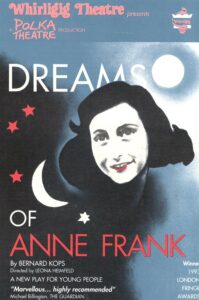 Over the next few years there were many false starts. We had a meeting with Richard Eyre at the National Theatre, in the hope of encouraging him to do more children’s theatre – and maybe to invite one of our productions to the National. We thought about becoming a charity, and investigated the Heritage Lottery Fund. We spoke to several companies about working with them. We carried on trying to find financial support. In 1993, knowing that there was no chance of funding from the Arts Council for a conventional Whirligig production, we proposed to them that we might tour the excellent Polka Theatre production of Dreams of Anne Frank, by Bernard Kops. This was a play for older children and teenagers. I had seen it and much admired it at Polka, a theatre on whose Board I sat. Polka liked the idea of a tour, and eventually Arts Council Touring agreed to support it, to the tune of £20,000. This was not as much as our estimated deficit, but was enough to convince us to go ahead.
Over the next few years there were many false starts. We had a meeting with Richard Eyre at the National Theatre, in the hope of encouraging him to do more children’s theatre – and maybe to invite one of our productions to the National. We thought about becoming a charity, and investigated the Heritage Lottery Fund. We spoke to several companies about working with them. We carried on trying to find financial support. In 1993, knowing that there was no chance of funding from the Arts Council for a conventional Whirligig production, we proposed to them that we might tour the excellent Polka Theatre production of Dreams of Anne Frank, by Bernard Kops. This was a play for older children and teenagers. I had seen it and much admired it at Polka, a theatre on whose Board I sat. Polka liked the idea of a tour, and eventually Arts Council Touring agreed to support it, to the tune of £20,000. This was not as much as our estimated deficit, but was enough to convince us to go ahead.
Several of Whirligig’s friends invested a little in the production. Altogether we raised £50,000, as well as the Arts Council’s £20,000.
To our embarrassment and dismay, the production, though it received splendid reviews, failed completely at the box office. The loss was approximately £75,000. A terrible result. We wrote to all the investors, apologising for the fact that their money had gone. This was our worst box office response since we began in 1979. One possibility was that by doing a production aimed at an older age range, we had confused our regular supporters in the primary schools. But, in any event, theatre had certainly seemed to drop in schools’ lists of priorities.
It was ironic, because we spent a considerable amount of money on concentrated telephone sales to schools from every venue, sending an experienced theatre telephone sales-person to work with each box office staff. But to no avail.
We opened at the Wyvern Theatre Swindon, then played the Beck Theatre Hayes, New Theatre Hull, Tameside Hippodrome Manchester, Palace Theatre Newark, Oxford Playhouse, followed by a short season at the Shaw Theatre, London and a final week at the Princess Theatre, Torquay.
The acting company from Polka, were all new to Whirligig. They did a splendid job under the excellent direction of Leona Heimfeld.
1994
It was obvious to us that this experiment – taking a play from another theatre company on tour, had not worked well enough for the Arts Council to suddenly offer more support to Whirligig. And it was no surprise that we found ourselves unable to tour in 1994. This was also the year in which Barbara Shipton (Scott) left us for pastures new, having been a huge help as part-time secretary and administration assistant.
(It is worth recording at this point the fact that Whirligig’s creative team, including myself, were not sitting idle during this difficult time for Whirligig. In 1990 I had been approached by Clarion Productions to adapt and direct Roald Dahl’s The BFG. After a certain amount of dithering, partly because the task was daunting and partly because Clarion was a commercial company, whose motives I, probably unfairly, suspected, I took the plunge and took my creative team with me. The BFG opened early in 1991 to enormous success. It toured to all the major theatres, selling out in huge auditoria, and leading to a Christmas season in London’s West End at the Albery Theatre. This commercial success led to another Dahl adaptation – The Witches – in 1992, and other Clarion productions including Noddy. This was, of course, very pleasing, but there was an irony, too, in that we realised that big, commercial titles were probably essential in order to achieve the kind of audience figures we, in Whirligig, aspired to. This showed, I suppose, that the demand for theatre for young audiences was indeed there, and had, perhaps, been partly created by Whirligig’s activities over the past decade and more. Dahl proved to have a very broad appeal. Clarion put on the show in the evenings at 7.00 pm, something we would never have dreamed of doing with a Whirligig tour. This meant that schools audiences came in their droves in the daytime, as well as large public audiences in the evening. Many adults came on their own, either having read the Dahl novels when they were younger, or simply because they admired Dahl the writer, who also wrote stories for adults. All this gave us food for thought …)
1995
1995 was another frustrating year, in which several initiatives, having shown promise, fell by the wayside.
Andrew Jowett, who had previously run Darlington Civic Theatre and the University of Warwick Arts Centre, was now running the wonderful new Symphony Hall in Birmingham. He was interested in the idea of us working with local schools and presenting several performances of Dinosaurs and All That Rubbish. It was not to be.
We discussed Goodnight Mister Tom again. Chris Grady, who ran the Buxton Festival of New Musicals, where we had first seen a workshop version of the show written by Michelle Magorian and Gary Carpenter, told us that the musical might start taking off, having been published by Weinbergers, but that perhaps a play version, presented by Whirligig, might exist side by side with it … but this was too expensive a proposition to take forward, bearing in mind our knowledge that Arts Council Touring would be unlikely to show support.
Barry Sheppard talked to various people including Edward Snape, who all were experiencing difficulties with touring theatre for young people – the business just didn’t seem to be there and the schools weren’t coming, possibly because of the Education Reform Act. But we heard that Vanessa Ford’s production of The Lion, The Witch And The Wardrobe was doing quite well.
We started discussions with the Theatre of Comedy Company, based at the Shaftesbury Theatre. Nick Salmon, the Chief Executive, had shown interest in Whirligig’s work, and he wondered whether we might somehow work with his company, either by putting on shows at the Shaftesbury, on top of the evening shows, or by forming an alliance with Bromley – the Churchill Theatre – , which could mean that Whirligig would have a base. Discussions continued for some time, but never reached a conclusion.
We talked to Martin McCallum at Cameron’s office. We discussed how we might ‘think bigger’. Should we be doing more commercial product?
We wondered about touring a production of Robin Hood, the musical I had co-written with Dave and Toni Arthur for the Nottingham Playhouse. We wondered about an open air production. We wrote to Ian Talbot, who ran the Open Air Theatre in Regent’s Park. We thought this might make a production that would be of interest to the Foundation for Sport and the Arts. But apparently we were barking up the wrong tree!
There was the possibility of working in association with several theatres, but even Peter Tod, our ally at Birmingham Hippodrome, was unable to make things happen.
So another year went by without a Whirligig tour.
1996
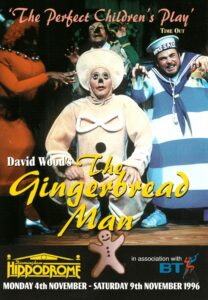 But our discussions with Peter Tod led to an exciting event the following year, 1996. Peter asked if Whirligig might be able to bring The Gingerbread Man to the Birmingham Hippodrome for one week – ten performances, all matinees. His idea was to crack the problem of schools not coming to the theatre by making them an offer they could hardly refuse. The seat price was very low indeed, and he also offered to organise transport, often a major problem for the schools.
But our discussions with Peter Tod led to an exciting event the following year, 1996. Peter asked if Whirligig might be able to bring The Gingerbread Man to the Birmingham Hippodrome for one week – ten performances, all matinees. His idea was to crack the problem of schools not coming to the theatre by making them an offer they could hardly refuse. The seat price was very low indeed, and he also offered to organise transport, often a major problem for the schools.
We put together a brilliant cast, many of whom had been in the show before. Tony Jackson returned to play the title role, Keith Varnier, the original Sleek the Mouse came back, 20 years later, to reprise his iconic performance. Mike Elles played Cuckoo, Terence Frisch and Beejaye were Salt and Pepper, and the wonderful Rosemary Ashe made her Whirligig debut playing The Old (Tea) Bag. What a great company they were. Robert Ornbo lit the Welsh dresser beautifully. Susie supervised the refurbishment of the set, Sheila choreographed and Peter not only supervised, but was the Musical Director and played the keyboards.
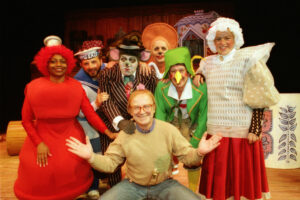
It really was an excellent production. I had been a bit worried that the theatre was too large, but there seemed to be no problem. In fact the whole project was a minor triumph. Approximately 12,000 children saw the production in one week. We got some lovely press attention too. We really hoped that it might lead to something more permanent in Birmingham, or that other theatres would use Whirligig in a similar way, to challenge schools into making visits to the theatre.
We hoped that this production might do a London season at the Old Vic, but it was not to be. But at least Whirligig was, we felt, back in business with a bang.
1996 was also the year when we decided to join the many companies encouraged to apply for a Lottery grant. In June 1996, Arts Council England put out a consultative document about new Lottery programmes. Encouragement was given to new work, embracing the creative abilities of young people and offering access and participation.
There was also another pot of money we were entitled to apply for – a Pilot Stabilisation Programme. Barry presented a careful application, but it didn’t succeed.
To back up our applications for lottery money, I produced a document called The Whirligig Vision, setting out the aims of the company and the previous achievements since 1979. The document set out plans for the establishment of a three year operation, which would need considerable funding to enable us to employ personnel regularly, to plan ahead and commission new work, and to ‘recognise and address the problems caused by the substantial gap between production costs (no less than equivalent adult productions) and low potential revenue (seats sold at a third of the normal adult price)’.
Proper funding would enable us to offer favourable deals to theatres to encourage them to take a children’s show. We could also have an office and proper storage facilities. (Up until this point, I had personally been paying approximately £5,000 a year to store our sets and costumes).
We wanted to create regular attachments and apprenticeships for directors, designers, choreographers, musical composers and directors who wished to specialise in children’s theatre. And we wanted to be able to encourage new writers.
In other words, we wanted the chance to revitalise the company and almost to start again, using all the knowledge and expertise we had gained over the previous years.
Sadly, we failed to convince the powers that be, and didn’t receive any lottery money.
However, in July of 1996 we were excited to start exploring another scheme, which was to come to successful fruition the following year, 1997.
1997
Barclays Bank and Arts Council Touring announced a new initiative. The idea was that companies could apply for funding to support a touring production, provided there were three companies or theatres involved. Peter Tod had expressed a strong interest in us returning to the Birmingham Hippodrome, following the success of The Gingerbread Man. Now we needed another theatre to come in with us and share basic costs. Manchester Library Theatre came on board, offering us the Christmas season at the Forum Theatre, Wythenshawe.
We asked Bill Kallaway if he could help us with our application to Barclays Stage Partners. He gave us some useful information and, indeed, spoke to the Arts Council people about our idea. He discovered that there was no objection to an application coming in for a children’s production, but that they did not want revivals. They only wanted brand new productions. Ideally they wanted new plays.
But a figure of £150,000 was mentioned. Bill suggested that we put in an application for a tour beginning in autumn 1997.
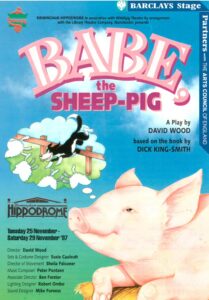
Not long before I had had a call from the much-respected literary agent, Rod Hall, at AP Watt. He asked me if I knew the book The Sheep-Pig by Dick King-Smith. I replied that indeed I did, having read it to both daughters, who enjoyed it immensely, and to whom I had remarked, ‘we have just read a classic’. The film Babe had been produced, based on the book, which I had also enjoyed. But, until Rod’s phone call, I had never thought of the possibility of adapting it into a play. Rod said that the feeling was that a play would eventually take the stage, and that he and Dick King-Smith would like me to do it. This generous offer led to me thinking hard about how to do a play version. I soon realised that we needed a flock of sheep on stage! Plus some puppies! The use of children in the cast seemed essential.
It wasn’t long before the idea of suggesting this play for the Barclays Stage Partners scheme was agreed. And it wasn’t long before, to our delight, the idea was approved.
Preparations for the production began. We were back in business with a vengeance. Susie designed it. Peter wrote incidental music. Most of our production team were back on board. Sheila Falconer was having an operation, but gamely played a role in advising on the movement, and, indeed, coming to some rehearsals to help us. We rehearsed in Manchester, which was not ideal, but was financially sensible. We opened at the New Victoria Theatre, Woking, then played at Birmingham Hippodrome, followed by our Christmas season at the Forum, Wythenshawe. After a holiday week, we then toured to the Hall for Cornwall Truro, Warwick University Arts Centre, Festival Theatre Edinburgh, Grand Opera House Belfast, Theatre Royal Norwich, Queen’s Theatre Barnstable, Marlowe Theatre Canterbury, Hackney Empire, Theatre Royal Nottingham, Grand Theatre Leeds, Theatre Royal Bath, Derngate Northampton, Grand Theatre Blackpool, Tyne Theatre Newcastle, Oxford Playhouse, Orchard Theatre Dartford, Lyceum Theatre Sheffield and Grand Theatre Swansea. This was the best tour ever, date-wise, for Whirligig, and proved that the major theatres were now interested in this kind of product and in attracting audiences of school children and families.
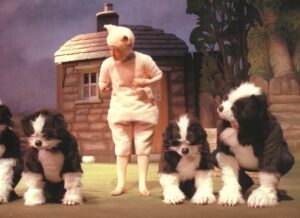
Emma Clayton came on board as assistant director, recruiting and rehearsing all the young people, who joined the show at every theatre we played. Emma made what might have been a logistical nightmare work brilliantly. For the local children in the play, it was a great experience, and their presence in the production proved very useful, publicity-wise.
Reviews were great, though business was not as good as we might have expected. The effects of the Education Reform Act were still being felt. And we did wonder whether the play had come too soon after the film. Did people feel that the play version couldn’t be as good as the film? Maybe.
We certainly felt that we were back on the scene. The tour received a lot of publicity. The Barclays connection meant that we were included in all the promotional material for the whole scheme. We were the only children’s production, so benefited whenever the scheme got national publicity, which included all the participants.
I suppose we hoped that this would lead to another explosion of activity, towards the idea of Whirligig becoming a bigger company, perhaps with a base, doing more productions per year. But this was not to be!
One of the great joys of working on Babe, the Sheep-Pig was meeting and becoming friends with the wonderful Dick King-Smith. I had admired him hugely for several years, having seen his appearances on early morning children’s television, when his previous life as a farmer was used to full advantage, as he talked about animals and introduced his audience to life on a working farm. He was a television natural, in that he talked straight to camera without any sign of patronising his audience. He simply and infectiously shared his enthusiasms.
When I sent him the first draft of my adaptation, he wrote back a handwritten letter. It is always daunting sharing a first draft with the original author, but Dick, with typical humour, informed me that I had got something extremely wrong. My heart sank, imaging the copious rewrites that were going to be necessary. However, he went on to say that throughout the play I had called a shotgun a ‘rifle’. I was clearly not a countryman! Phew! When Dick came to see the play at the Theatre Royal, Bath, he was very generous in his praise, insisted on meeting everybody and agreed to be photographed with the cast. In the following years I visited him regularly, and we enjoyed many lunches. Together we visited another production of the play at the Sherman Theatre, Cardiff. As we sat next to each other, Dick realised he couldn’t hear me talking very clearly. He told me that he was partially deaf in his left ear. I replied that, following the shooting of a sten gun in the film IF…. many years before, I was partially deaf in my right ear. We agreed to swap places and were able to converse easily. From that day on, whenever he wrote to me, Dick addressed me as ‘Dear D.I.R.E.’, which translated as Deaf In Right Ear. I followed his lead, so he became ‘D.I.L.E.’.
Apart from Dinosaurs and All That Rubbish, which was adapted from the book by the brilliant author/illustrator, Michael Foreman and The Old Man of Lochnagar, Prince Charles’s book, Babe the Sheep-Pig was the first adaptation Whirligig had presented. I suppose The Owl and The Pussycat went to See… was very much inspired by Edward Lear, but the through storyline was original. The Gingerbread Man used the familiar title, but was my own story. This reflected my feeling at the time that adaptation, in children’s theatre, was almost ‘cheating’. It worried me – as it still does (in 2014) that children’s theatre is often thought of as the adaptation of well known children’s books. It seemed to me that the craft of playwriting for children was just as much to do with writing original plays. If Alan Ayckbourn or Tom Stoppard, writing plays for adults, were suddenly told that they could no longer write original plays, only adaptations, people would think that very strange. But in the children’s theatre world, perhaps because teachers and parents are relatively conservative creatures, who want to play safe when taking their children to the theatre, adaptation is rife.
Having adapted many books since Whirligig days, and having accepted the fact that well known titles are necessary to attract audiences, I look back with gratitude on the Whirligig years, because, as the company became better known, many teachers and parents came to see our work, simply because the word Whirligig meant quality. The title of the play was irrelevant. Just as people go to see a ballet performed by Ballet Rambert without necessarily needing to know which ballet they are going to see.
The money from Barclays Stage Partners helped us develop our liaison with teachers at all the venues we visited. We were able to employ Su Newell, who compiled a splendid booklet of teachers’ notes, showing how the play could be ‘used’ within several areas of the National Curriculum.
The casting of Babe, The Sheep-Pig brought back the talents of previous Whirligig actors, David Burrows and Mary-Ann Coburn. Mary-Ann had joined us for The Old Man of Lochnagar and later played Dunnock in The See-Saw Tree. David had started with us as an Assistant Stage Manager/understudy, and became a regular. He was a particularly good Chips, the street wise cat, in our second production of The Ideal Gnome Expedition.
Anthony Pedley, who had created the role of The BFG for me in my adaptation/production for Clarion, joined us to splendidly play Farmer Hoggett, Judy Wilson played his wife. Judy had played Grandmother in The Witches, another Clarion production of one of my Roald Dahl adaptations. Karen Briffett, who had created the role of Boy in The Witches, and who also played Noddy for me, was a very appealing Babe. Kirsty Kinnear, daughter of Roy, sister of Rory, joined us from drama school to play Ma. Gary Bates and Amanda Kernot were both newcomers to the company. They came as boyfriend and girlfriend, and not long after the tour were married. Emma Clayton, having agreed to recruit and rehearse all the local children as sheep and puppies, asked if she could be in the show as well. Logistically this seemed impossible, but somehow Emma made it work. She became a delightful Cat and Duck, and bleated beautifully as the main Sheep.
Cliff Atkinson, who had been our musical director on many productions, returned to play the keyboards.
Meanwhile, all our efforts to secure Whirligig’s future were falling on deaf ears. In 1996 we had spent some time working on a National Lottery Application. We asked David Jackson and Associates to prepare ‘a development study’ to accompany the application, which reinforced all our own arguments. I had a meeting at the Arts Council with Lady Gowrie, not officially an Arts Council meeting, but a chance to discuss in general the problems of children’s theatre, in her husband Lord Gowrie’s office. But all these efforts, through 1996 and 1997 led to disappointment. The one-off tour of Babe, the Sheep-Pig was a welcome chance to return to theatre production, and we were delighted with the success of the operation.
But Barclays Stage Partners made it clear that they were not interested in us applying for similar funding the following year. So really we were back to square one.
1998
However, Peter Tod, at Birmingham Hippodrome, having championed our cause by inviting us to play The Gingerbread Man in 1996, and having become one of the partners in the production of Babe, the Sheep-Pig, tried hard to find a way of working with Whirligig again in 1998. The idea we discussed was to revive Dinosaurs and All That Rubbish, the show we had first produced in 1998, using two professional actors and a large cast of children. We had performed it at Sadler’s Wells, the Grand Theatre, Swansea and Darlington Arts Centre. Peter now thought that a similar project, mounted solely for Birmingham Hippodrome, could attract funding as well as audiences. We approached Peter Duncan, who had been in the original production, and he was very interested in returning. We contacted various team members and pencilled them in for a November opening.
Barry and John carefully worked out a budget. We needed £45,000 to make the project work. Eventually, Peter was able to offer £35,000. But no more. A last ditch attempt to raise the final £10,000 involved us contacting Cameron Mackintosh in Australia. But it was too late. It was certainly not his fault but he was unable to help, so sadly the pre-production work stopped and the project was aborted.
It was during this time that Val McMillan, a Birmingham resident, encouraged us to establish a base in Birmingham. I think she saw us as a possible National Children’s Theatre. We considered the idea, but without huge support and funding from all sorts of organisations, we knew the idea was unlikely to succeed. Not only that, it would mean Whirligig becoming a charity, something we had investigated before. On the surface it seemed like a good idea, because charities can attract funding from charitable trusts and the like. But becoming a charity means giving up autonomy, which I was reluctant to do. I had been on the Board of Polka Theatre, established as a charity, when the Arts Council announced that unless Richard Gill, the Artistic Director and Founder, gave up his leadership of the company, they would withdraw funding. They had decided that they no longer liked his house style, and wanted more practitioners to be able to show their skills. Richard, to save the company, resigned. This, at the time, had seemed to me an unfair sacrifice to be forced to make. Richard was a pioneer, who didn’t deserve to have his company taken away from him. Visions of a similar thing happening to me and Whirligig made me reluctant to go down the charity route.
1999
So there was no Whirligig tour in 1998, and the situation was not much better in 1999. However, we did embark on one exciting adventure. We received a call from Adrian Mitchell’s agent, who told us that the play Adrian had written for Unicorn Theatre had been due to go to a theatre in New York State, as an exchange for a production from NYSTI, the New York State Theatre Institute, coming to Unicorn’s base at the Arts Theatre, London. The American company had already visited, but now Unicorn discovered they just could not fund the return visit. Whirligig was offered the chance of taking their place.
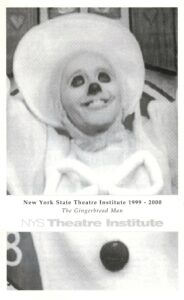 After meetings and lengthy fax exchanges with Patricia Di Benedetto Snyder, it was agreed that we would take The Gingerbread Man to Troy in New York State, for just a week of performances.
After meetings and lengthy fax exchanges with Patricia Di Benedetto Snyder, it was agreed that we would take The Gingerbread Man to Troy in New York State, for just a week of performances.
To make the figures work, the company had to all agree to do it virtually for expenses. We decided that 15 of us should make the trip. The cast, all six of them, had played in productions of The Gingerbread Man before. Mike Elles returned to play Cuckoo, Terence Frisch and Beejaye played Salt and Pepper and Tony Jackson returned for the umpteenth time to be a really excellent Gingerbread Man. Keith Varnier, the original Sleek the Mouse, was back, twenty three years after having created the role. Julia Sutton, who had played the part for me at Unicorn, was our vibrant Old (Tea) Bag. Kevin Chadderton was the Company Manager and was also ‘on the book’. Sheila choreographed. Peter was Musical Director, and Keith Hutchinson and Rachel Corderoy, who had recently married, were on sound and wardrobe respectively. It was decided that John and Barry should come along, as well as Bob West. Bob had been for many years Cameron’s most respected Company Manager. When Cameron and I toured The Gingerbread Man, Bob got to know the production and the set as well if not better than anyone. He had also lit the production on several occasions. So he came to Troy to assist with the building of the set and to light the show.
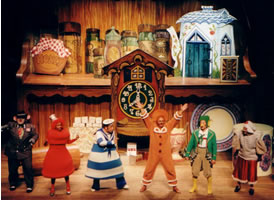 In some ways this was an adventure that echoed the Dubai experience earlier in the year. The Gingerbread Man had been only the second British children’s play to be taken from the UK to Dubai. But Whirligig were not the producers. Bob West and I, as W2 Productions had produced it. Now, for America, several of the cast returned, plus several of the production team.
In some ways this was an adventure that echoed the Dubai experience earlier in the year. The Gingerbread Man had been only the second British children’s play to be taken from the UK to Dubai. But Whirligig were not the producers. Bob West and I, as W2 Productions had produced it. Now, for America, several of the cast returned, plus several of the production team.
The experience was not only extremely enjoyable, it was exciting to see American children reacting so similarly to their British counterparts. We were given a great welcome by NYSTI, and once again the Whirligig team did a great job. Once again, Barry, John and I found ourselves wondering why on earth the company could not become more stable and established. By now we had been producing for 20 years, but the future of the company was still as uncertain as it ever had been.
(It should be noted at this point that children’s theatre generally was developing in the UK, and that many Whirligig folk, including myself, were involved. My Roald Dahl adaptations continued to be well received. Other companies toured productions that were more overtly commercial than our own. But there was surely still room for a company dedicated to providing work of high quality but low seat-price, to enable school children all over the country to experience live theatre. The more commercial companies did not have quite the same philosophy. Financial considerations had to take precedence over a passionate desire to provide a public service.)
2000
In 2000, perhaps discouraged by our inability to secure regular funding from the Arts Council, John, Barry and I relaxed our attempts to achieve a Whirligig tour. Meanwhile, Tish Francis and Hedda Beeby at the Oxford Playhouse had invited me to produce and direct two productions there, Spot’s Birthday Party and The Lighthouse Keeper’s Lunch. This seemed, at first, strange, because they wanted me to work with a new team, in the hope that they might set up a children’s theatre division within the Playhouse. In the end, both productions were highly enjoyable and Spot embarked upon a tour which, apart from the fact that it was aimed at the under-fives, followed a similar pattern to a Whirligig tour.
It was during 2000 that I also began work on Philippa Pearce’s Tom’s Midnight Garden, commissioned by Tony Graham at Unicorn Theatre. This opened in October. Also, my adaptation of Roald Dahl’s The Twits, commissioned by the Belgrade Theatre, Coventry the year before, commenced another run. I was also performing my Magic and Music Show. And my book, co-created with Richard Fowler, Funny Bunny’s Magic Show, was published in this year.
But, sadly, no developments for Whirligig.
2001
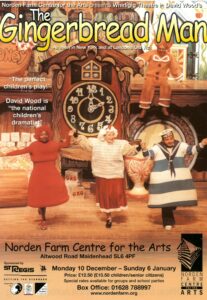 2001 was the 25th anniversary of the first performance of The Gingerbread Man. I was hoping that a celebratory production might be mounted, perhaps in London.
2001 was the 25th anniversary of the first performance of The Gingerbread Man. I was hoping that a celebratory production might be mounted, perhaps in London.
But, out of the blue, a phone call came from David Hill, who ran the brand new theatre venue, Norden Farm Centre for the Arts in Maidenhead. This complex boasted a splendid theatre within a barn.
David Hill had previously worked at Birmingham Hippodrome and at the Everyman Theatre, Cheltenham. He had worked on marketing, helping us sell children’s shows at Birmingham, and had invited me to talk to children’s theatre enthusiasts at Cheltenham. Now he was inviting Whirligig to bring The Gingerbread Man to Maidenhead for a Christmas season. He had not realised it was the 25th anniversary.
John and Barry worked out a budget, and it all seemed possible. We agreed a four week season, and assembled an excellent cast. Mike Elles returned as Cuckoo, Shelaagh Ferrell played Pepper, not for the first time. Neil Smye, who had understudied and played the role before, played the Gingerbread Man. Newcomers to Whirligig were Michael Geary as Sleek the Mouse, Tom Sutton as Salt and Carol Ann Wilson as The Old Bag.
Sheila returned to choreograph. Susie refurbished her set and costumes, Adam Stafford became my Associate Director, and Matthew Freeman, who had previously been one of the musical directors of Meg and Mog Show for Unicorn, came on board as MD and keyboard player.
We had a happy season. Business was not, perhaps, as brisk as we might have hoped. But no money was lost and the production was extremely well received.
2002
There was no Whirligig activity in 2002. John, Barry and I decided that perhaps the time had come to wind up the company. What was undoubtedly true was that the children’s theatre scene in the UK had changed radically since we started touring in 1979. More practitioners wanted to do the work, rather than seeing it as the first rung on the ladder. Writers, composers, actors, directors and designers were now seeing children’s theatre as a career option. Perhaps, we thought, our work is done. Not only that, we still had some money – not much – in the bank, so were not being forced to abandon ship.
We decided to hold a celebratory party, to which we would invite as many people as possible who had been connected with Whirligig shows. We decided it should take place the following year – in 2003, which would in effect be our 25th anniversary.
2003
And so it was that on Sunday, October 26th, 2003, we held a splendid party at Polka Theatre in Wimbledon, to which a gratifyingly large number of people came. Speeches were made. Whirligig performers past and present performed songs from the shows. There were video excerpts from productions on the big screen.
The end of an era. At times frustrating, but always stimulating and rewarding. In the opinion of many, Whirligig played a major role in changing attitudes towards children’s theatre in the UK, both amongst the professional theatre world and in the minds of the public. Children’s theatre productions had become part of the mainstream, both in regional producing houses as well as touring theatres. And also in London’s West End.
My thanks to everybody who contributed to Whirligig’s twenty five years on the road, particularly to Susie Caulcutt (designer), Sheila Falconer (choreographer), and Peter Pontzen (musical supervisor) for staying on board the Whirligig through thick and thin till the end of the ride, and John Gould and Barry Sheppard, without whom the company could not have existed and kept going, through adversity and triumph alike.
DAVID WOOD, March 2014